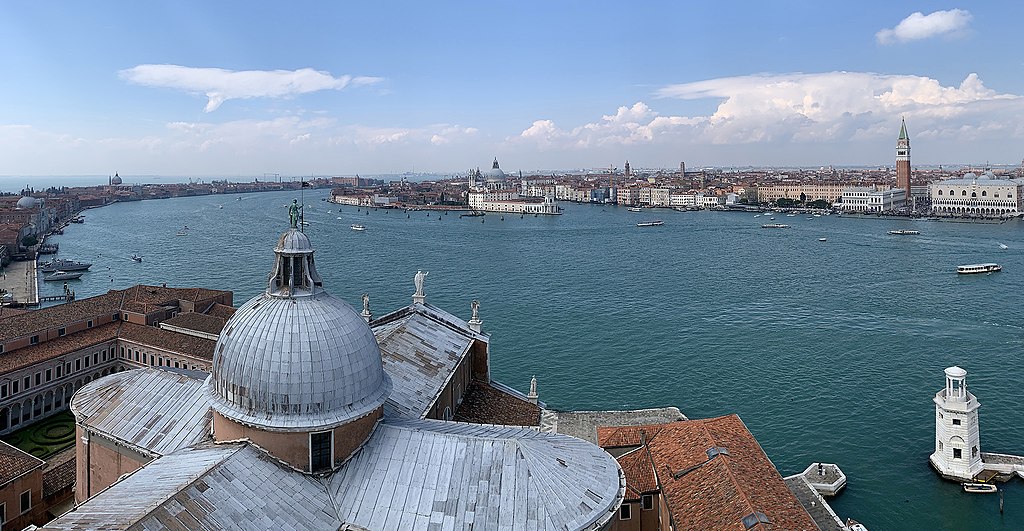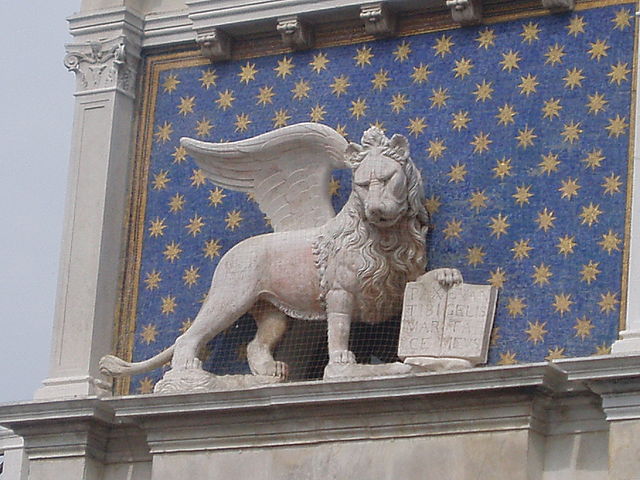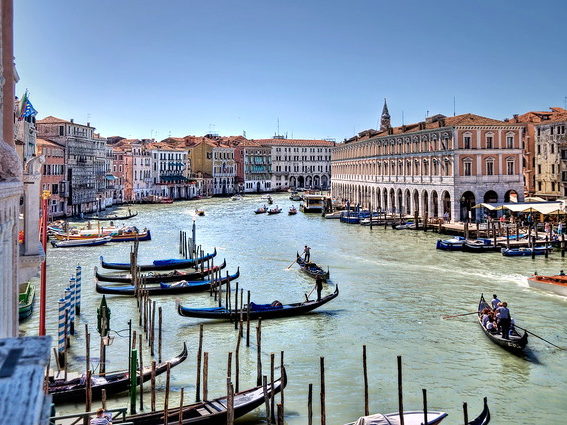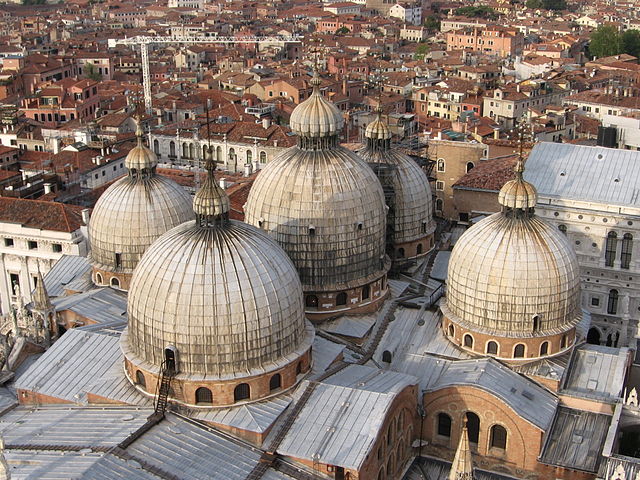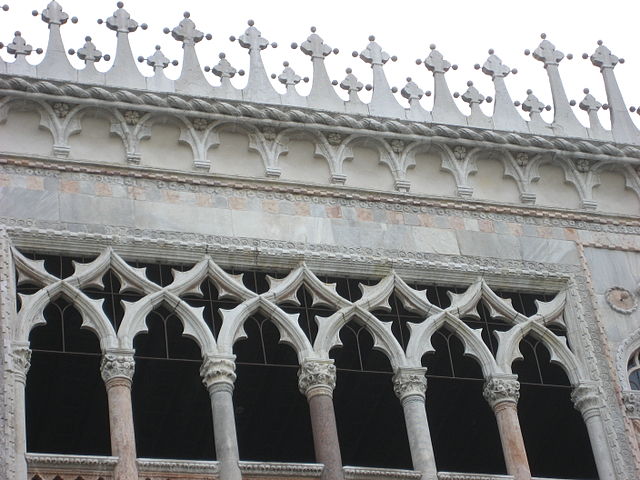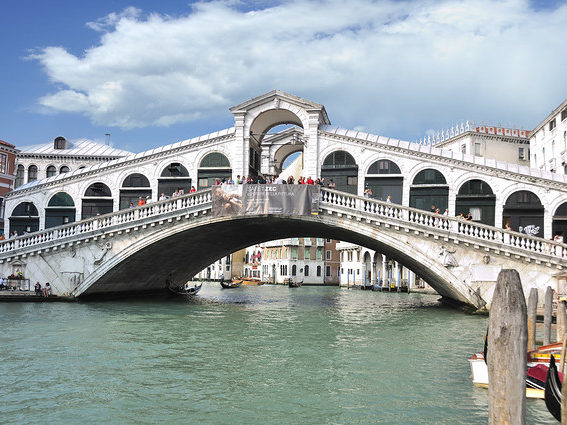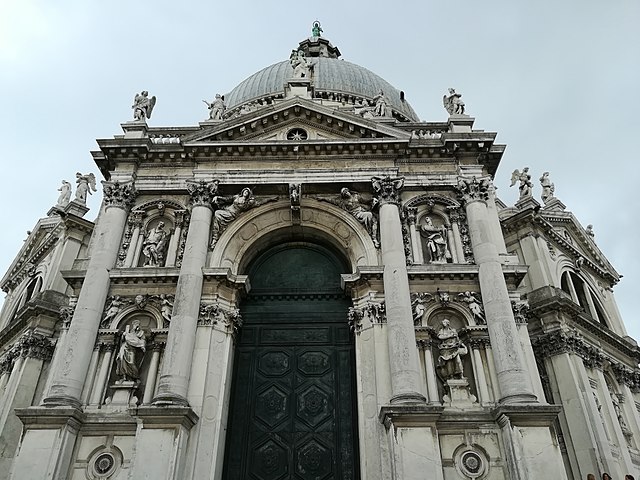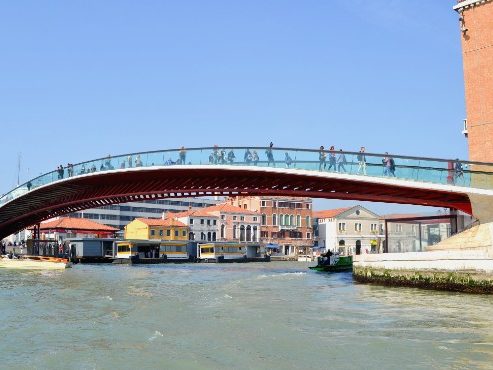Architecture of Venice, Italy
Venice is a city famous for both its canals and its incredible architecture. Venice started out as a cluster of islands that grew into a small fishing village in the early Middle Ages. Over time Venice transformed into one of Italy’s leading powers thanks to its vast trade network within the Eastern Mediterranean. The Republic of Venice was established at the end of the 7th century, and at its peak, it controlled a large territory stretching from Northern Italy to other areas in modern-day Croatia, Slovenia, Greece, and Cyprus. Venice peaked during the Gothic and Renaissance periods at which point the wealthy mercantile class commissioned incredible works of architecture throughout the city. Today Venice is one of the most popular tourist destinations on earth and visitors are constantly amazed by the former glory of the Venetian Republic.

Map of Venice
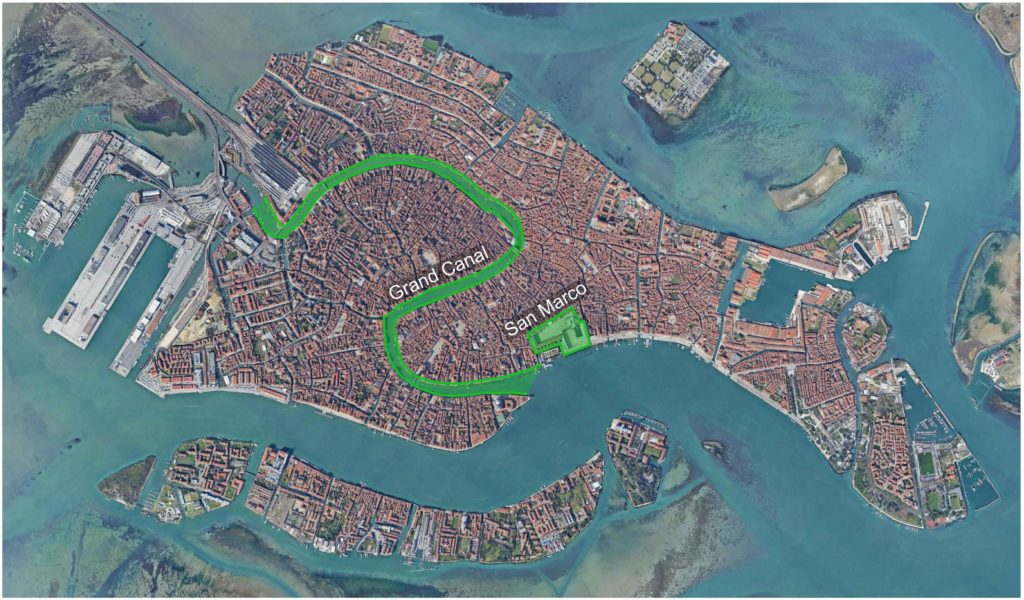
Map of Venice highlighting the Grand Canal and the San Marco Complex.
The vast majority of Venice’s greatest works of architecture are either along the Grand Canal or adjacent to Piazza San Marco.
Table of Contents
History of Venice
Unifying Elements in Venetian Architecture
Byzantine Influences
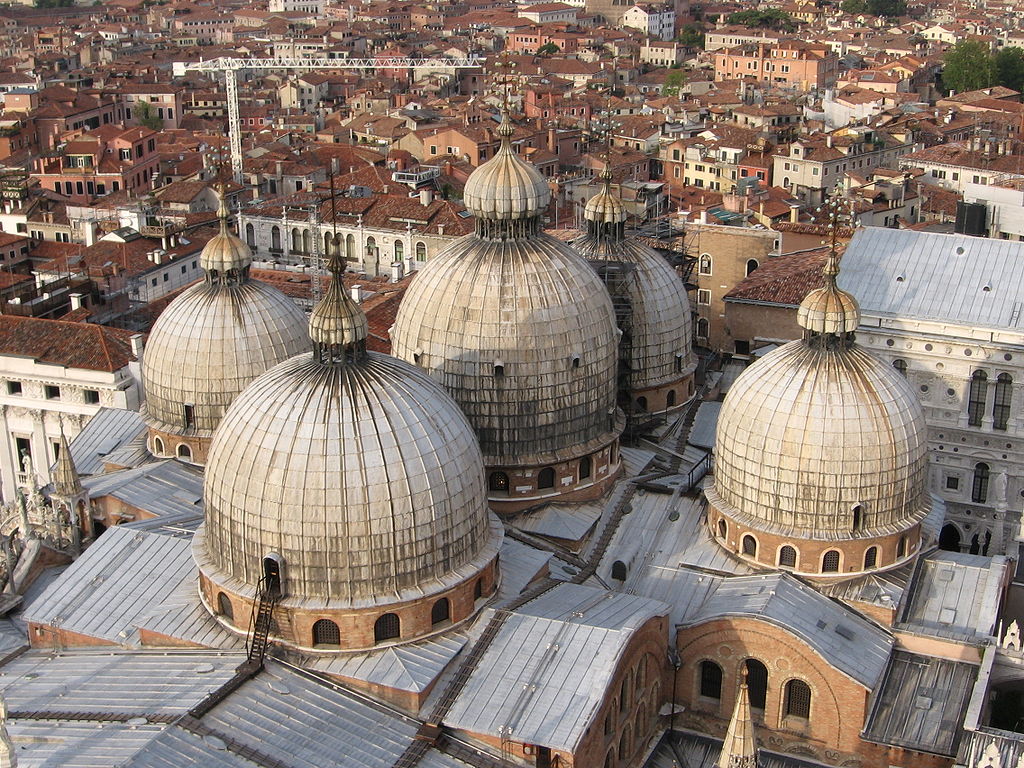
Venice was directly ruled by the Byzantine Empire in the 6th-7th centuries, and it remained an important trading partner with the Byzantines for centuries after that. Many important political figures in the Republic of Venice were eager to maintain a good relationship with the Byzantines since it was good for trade and commerce. Thanks to this relationship, Byzantine Influences can be found throughout the Architecture of Venice. This is particularly clear in older Venetian buildings such as St. Mark’s Basilica. Here you can see the domes of the basilica, which resemble several other domes on Byzantine Buildings. St. Mark’s Basilica was also built in a Greek Cross Plan, another distinct element borrowed from Byzantine Architecture.
White Istrian Marble
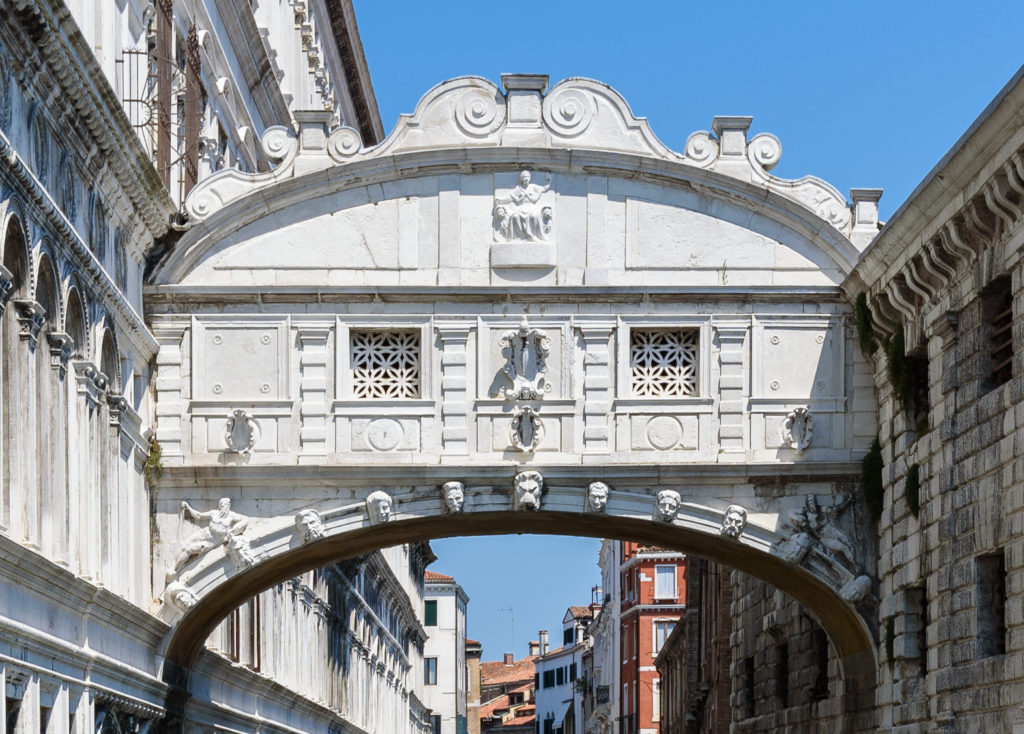
Istria, a region in the northern part of Croatia, was controlled by Venice during the early days of the Venetian Republic. Istria is known for its abundant marble deposits, and the marble in this region is special in many ways. First off, it’s a pristine white color, and it has been coveted since ancient times for its purity. Istrian Marble also happens to be one of the most robust materials on earth when it comes to erosion. Water wears away at Istrian Marble much slower than with other stones, and the Venetians used it to build many building foundations since they were so heavily exposed to moisture. Of course, the Istrian Marble Facades in the city get all of the attention, but it’s important to recognize that Venice is still standing today thanks in large part to the foundations made from this incredible material.
Canals

The canals are really what make Venice such a unique city. You won’t find any cars in the center of Venice, and the only way to get around is on foot, or on a boat. The Grand Canal, which is depicted above, is the main thoroughfare within the city. It’s lined with some of the most opulent palaces within Venice such as Ca’ d’Oro, Ca’ Loredan and Ca’ Farsetti. The Canals are also interesting because of how varied they are. The Grand Canal is known for being busy and often crowded, while other smaller canals can be quaint and quiet and out of the hustle and bustle of Venice’s crowds.
Venetian Gothic

One of the key points in Venetian Architectural History is the Venetian Gothic Period. Venetian Gothic is a subtype within Gothic Architecture. Venetian Gothic buildings all feature unifying characteristics such as Pointed Arches, Pinnacles, Tracery Stonework, and Stained Glass. In the Image of the Ca’ d’Oro above, you can see all of these different elements together. Venetian Gothic Architecture was also heavily repurposed in the Revival Period in architecture. One of the most famous examples of this is the city hall in Stockholm, Sweden, which borrows several design elements from Venetian Gothic.
Venetian Renaissance
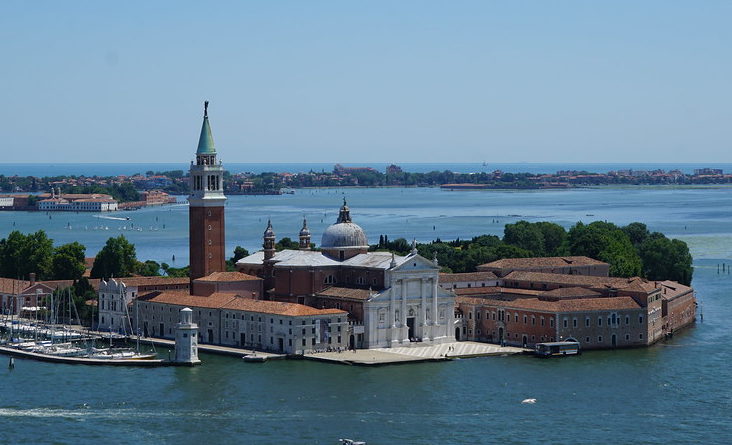
The Renaissance was another architectural movement that really took hold in Venice. The movement, which originally began in Florence, was born in the early 1400s. The Renaissance coincided with the Venetian Golden Age, and as a result, dozens of incredible Renaissance works of architecture can be found throughout the city such as Piazzo San Marco and the Rialto Bridge. The region around Venice was also home to one of the greatest architects of the Italian Renaissance, Andrea Palladio. Palladio designed a few different buildings within the city, including the San Giorgio Monastery which sits on its own island just across from Venice’s historic center.
The Venetian Lion
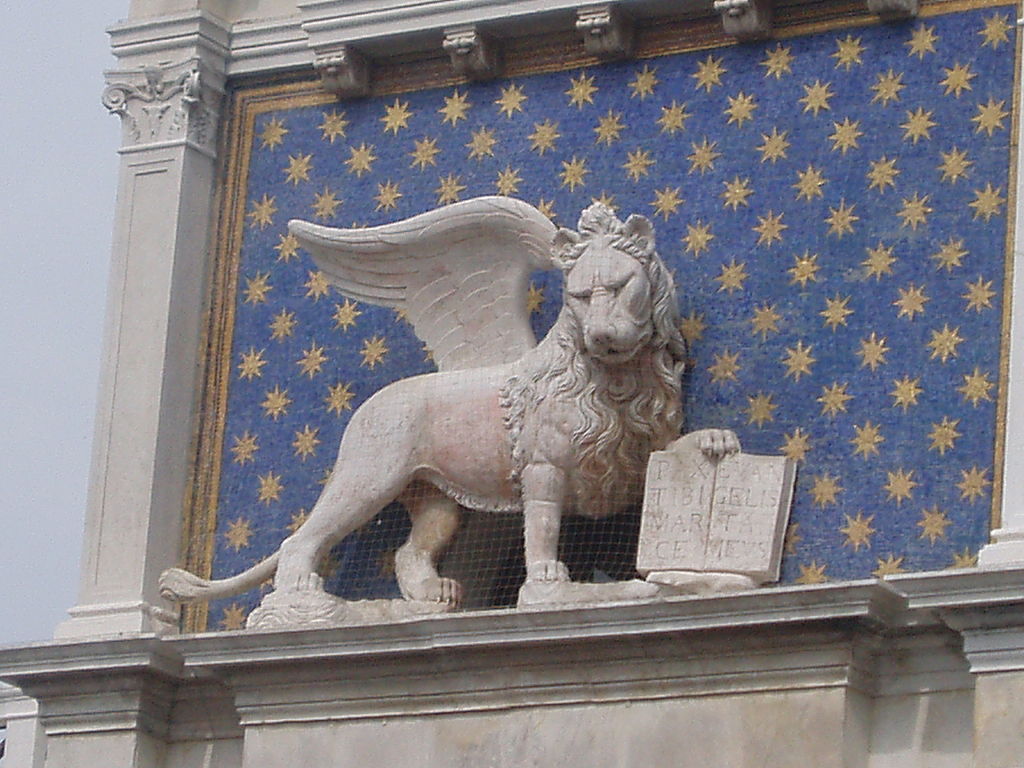
The Lion was the symbol of the Republic of Venice, and it appears throughout their formal crests and banners. The lion is always depicted with wings and is often holding a book or a sword. This symbol is found throughout the Architecture of the Venetian Republic – often at the tops of columns and within city walls and gates. There are dozens of stone lions throughout Venice, and even more are printed on flags and other memorabilia. Even though the Republic of Venice ended in 1797, the spirit of the once-powerful state still lives on. In the image above you can see a Venetian Lion within St. Mark’s Clocktower which overlooks the Piazza San Marco.
How did they build Venice?
Venice originated as a group of over 100 islands. But These islands were not really suitable for buildings because the soil was just soft mud. Some of the earliest works of Venetian Architecture didn’t last more than a few years because they were sinking down into the mud below in a process known as Building Settlement. To fix this, Venetian Engineers created a system for driving wooden piles deep into the mud and topping them with stone pavers. Using this method they were able to create new permanent land that was perfectly suited for supporting structures.
Byzantine and Romanesque Architecture in Venice
Some of the oldest buildings within Venice have foundations dating back to the Byzantine Period. Although the Byzantines wouldn’t control Venice past the 7th century, the city’s buildings were still heavily influenced by the Architecture of the Byzantine Empire. Eventually, by the 11th century Romanesque Architecture became the dominant style within the city. At this point in time Venice was still a smaller regional power. It wasn’t until the mid-1300s that the Republic of Venice really began to expand and take over other nearby cities, such as Treviso.

Map of Venice highlighting the most notable works of Byzantine & Romanesque Architecture within the city.
1. St. Mark’s Basilica
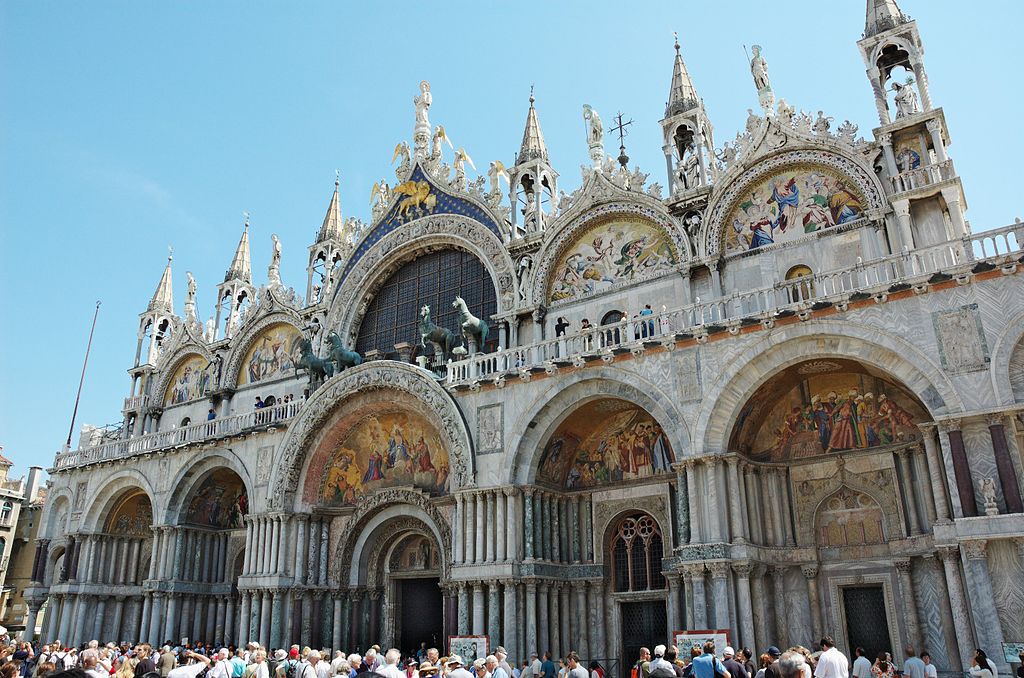
St. Mark’s Basilica is the principal church in Venice, and it’s named for the city’s patron saint. The main facade of the church faces Piazza San Marco and it’s directly adjacent to several of Venice’s other major sites such as the Doge’s Palace. Venice famously acquired the remains of St. Mark during the early Middle Ages when they were brought to the city by some Venetian merchants returning from Alexandria. Construction began on the current form of the church in 1063, and it was designed to be a fitting home for St. Mark’s remains.

St. Mark’s Basilica was designed in a Greek Cross Plan, which was different from the many Latin Cross Plan Churches found throughout the rest of Italy. The plan of the building in addition to the domes and some of the other details in the facade all show the heavy influence of Byzantine Architecture. Inside the church, you will find a plethora of Byzantine Style Mosaics, in addition to other relics and art pieces. It’s decorated in a similar manner to many of the great Byzantine buildings located in Istanbul, such as the Hagia Sophia and the Hagia Irene.
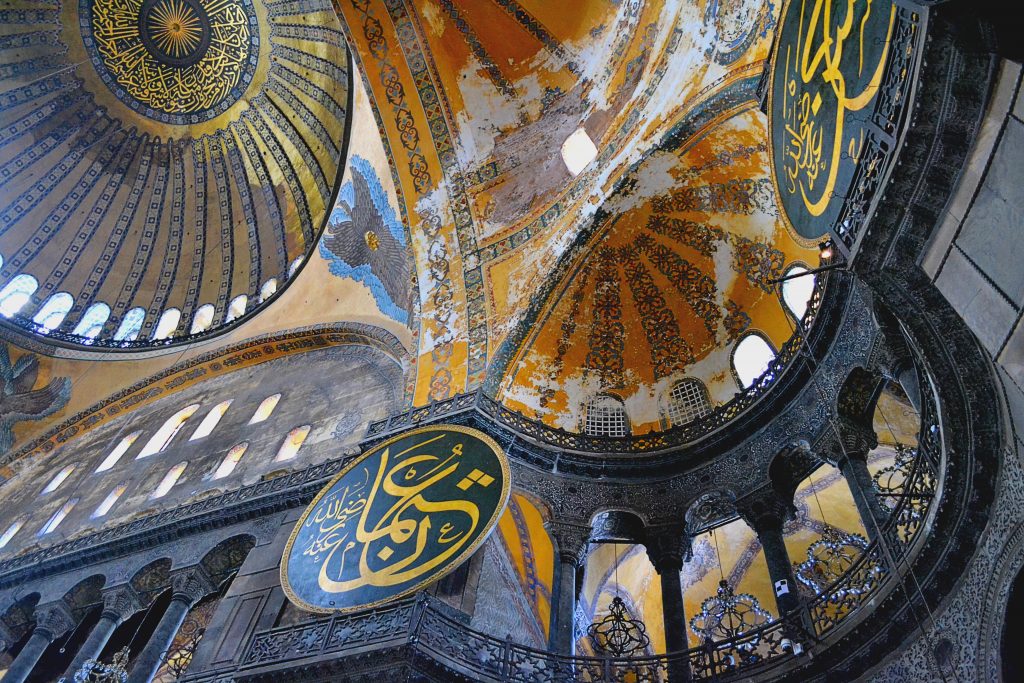
After the fall of the Western Roman Empire in 476 CE, the Eastern Roman Empire lived on for centuries. Also known as the Byzantine Empire, it would last until the fall of Constantinople in 1453. Check out our article, “Top 25 Examples of Byzantine Architecture” to learn more!
2. Ca’ Loredan and Ca’ Farsetti
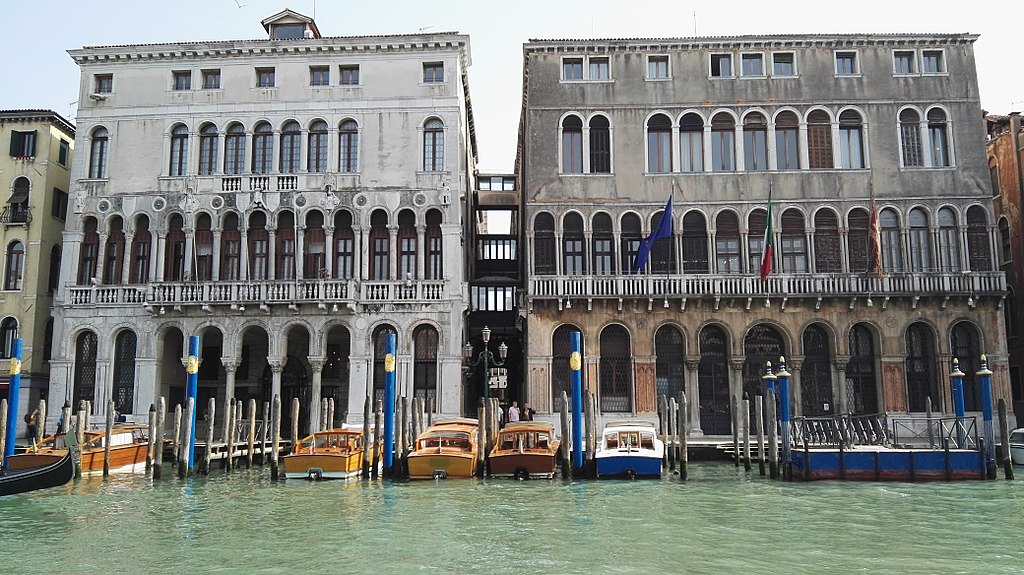
The Ca’ Loredan and Ca’ Farsetti, are two incredible works of Romanesque architecture within Venice. They overlook the famous Grand Canal that winds through the center of the city. Both Structures were built in a similar fashion, using all of the typical design elements from the Romanesque Style. These elements include the round arches, and the overall thick and stout construction of the buildings. Both of these palaces were built from the spoils of Venice’s vast trading network, which was rapidly growing during the Romanesque Period.
3. Venetian Arsenal
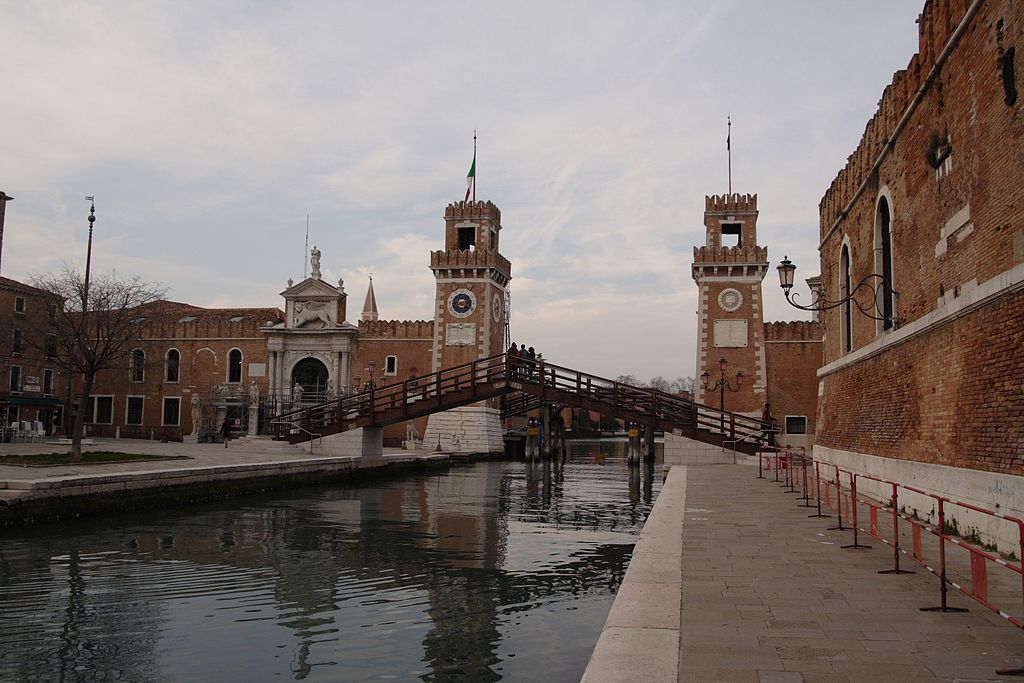
Venice was a maritime power, and all great maritime powers have one thing in common – a powerful navy. The Doge’s of Venice coordinated the building of the Venetian Arsenal, a portion of the city that was completely dedicated to shipbuilding. It was a mixture of drydocks and factories where the hulls of vessels, as well as their necessary internal components were all manufactured. Venice focused a great deal of time and resources perfecting the art of shipbuilding. The compound of buildings was said to be so efficient, that in a single day an entire Venetian Warship could be constructed from Bow to Stern.
4. Church of San Lorenzo

The Church of San Lorenzo is an early church in Venice that dates to the 9th century. The exterior is completely void of detail, and it is made of roughly cut bricks. This technique was common in Italy during the Middle Ages, and many churches in Northern Italy and Tuscany were built in a similar manner. A few other works of architecture in Venice were built this way, however, many of them were veneered with a thin layer of marble. Marble facades were added to churches frequently in the Renaissance, but it’s interesting to see the underlying structure behind the marble here at the Church of San Lorenzo.

Romanesque was Europe’s dominant architectural style from the 10th-11th century. Read our article, “Romanesque Architecture and the Top 15 Romanesque Buildings” to learn more!
Venetian Gothic Architecture
The Gothic Era in Architecture coincided with the Venetian Republic’s territorial expansion. From the 9th-14th centuries, the Republic of Venice gained a major foothold on the Italian Mainland and took control of several territories throughout the Adriatic Sea. The Croatian cities of Rovinj, Zadar, and Split were all part of the republic at one point, in addition to the Italian cities of Treviso, Chioggia, and Burano. All of these places saw an economic boom thanks to the Venetian Trading Network, and Venice itself also saw a huge building boom thanks to its growing domain. The Venetian Gothic Style emerged at this point, and it combines various Eastern and Western design elements into one cohesive Venetian Gothic form.
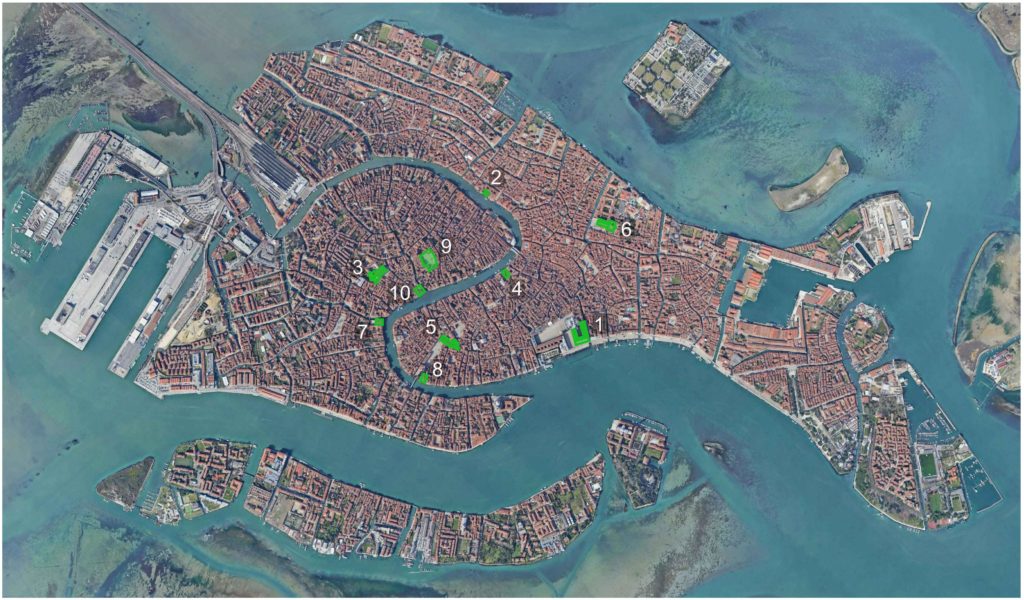
Map of Venice highlighting the most notable works of Venetian Gothic Architecture within the city.
1. Doge’s Palace

The Venetian Government was structured as a republic. The leader of Venice was an elected official known as the Doge, and the Doges were elected by a council of wealthy noble families. The Doge’s Palace acted as a sort of royal residence for the Venetian rulers, and it also served as a meeting space and a location to host guests from other nations. Construction began on the building in 1340, and it was heavily modified in subsequent centuries. Although most of the main elevations are Gothic, some of the courtyard facades were completely redone in the Renaissance Style.
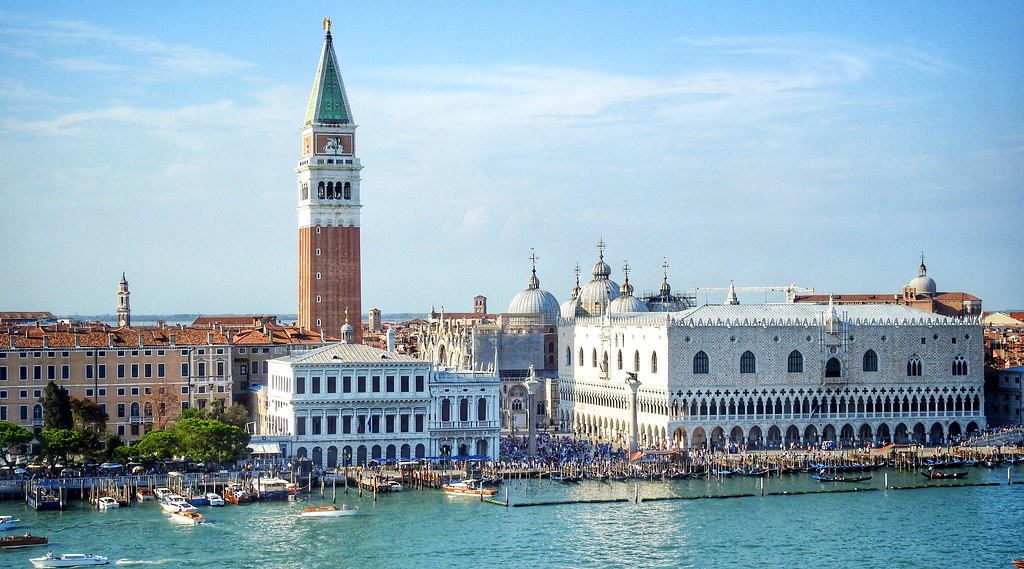
The symmetrical facades of the palace face the Venetian Lagoon on one side, and the Piazza San Marco on the other. The exterior is lined with a striking collonade of pointed arches. These white stone columns and arches are all intricately carved with Gothic Tracery. The striking architecture of the Doge’s Palace is what makes it one of the most notable buildings in all of Venice. Its located in the heart of the San Marco complex along with St. Mark’s Basilica, the Piazza San Marco, and St. Mark’s Campanile.
2. Ca’ d’Oro
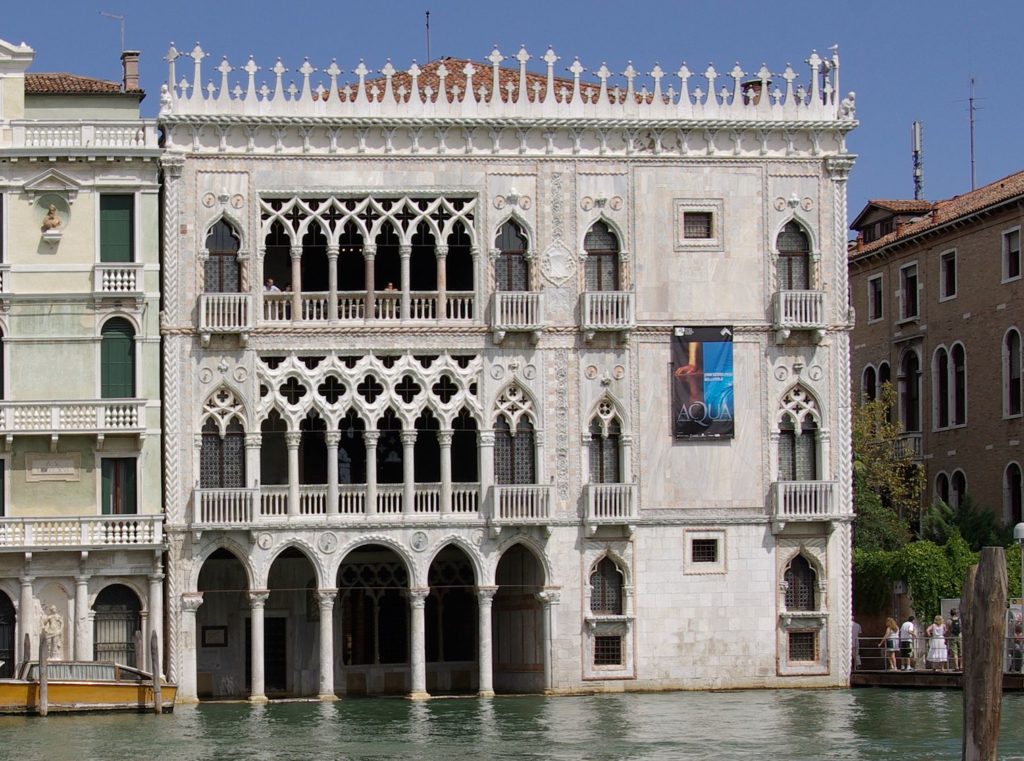
The name Ca’ d’Oro translates to Golden House and it was called this to dignify the opulent materials that were used throughout the building. The main facade of the palace overlooks the Grand Canal, and it’s often regarded as the greatest surviving work of Venetian Gothic Architecture. The arches on the second and third-floor balconies are the most striking elements in the building. The stonework is delicately carved with a level of detail that shows just how wealthy the owner of the palace must have been. Many of Venice’s wealthiest families built their residences along the Grand Canal as a way to show off to one another.
3. Santa Maria Gloriosa dei Frari

The church of Santa Maria Gloriosa dei Frari is one of three large Gothic churches in Venice made from brick – the others being Santi Giovanni e Paolo and Chiesa di Santo Stefano. Together these churches show a different side to Venetian Architecture when compared to the marble-clad palaces of the Grand Canal and Piazza San Marco. Although Santa Maria Gloriosa is largely void of details, it’s still striking for its size and its height. The bell tower is one of the tallest in the city, and the nave of the church is also one of the highest in Venice. Construction began on the church in the late 1300s, and took about a century to complete.

Gothic was the dominant architectural style in Europe during the early Middle Ages. Check out our article on the Top 25 Examples of Gothic Architecture to learn more!
4. Palazzo Bembo
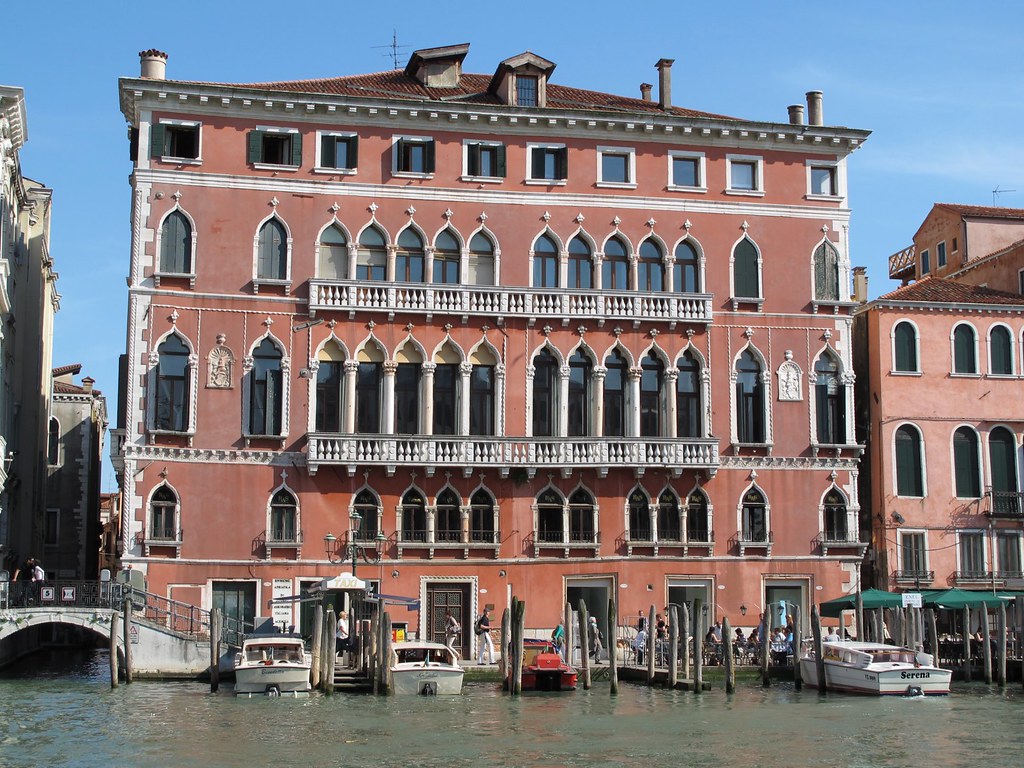
Like the Ca’ d’Oro, Palazzo Bembo is a palace built by a wealthy merchant family overlooking the Grand Canal. The Bembo Family commissioned the construction of the palace in the 15th century, and it is built in the Venetian Gothic Style. Although the materials arent quite as extravagant as the Ca’d’Oro, the Palazzo Bembo is the larger of the two buildings. Today the palace houses a popular 3-star hotel. It’s a very popular location thanks to its striking position overlooking the Grand Canal, and its close proximity to the Rialto Bridge and other popular attractions.
5. Chiesa di Santo Stefano

The Chiesa di Santo Stefano is another Gothic church located in Venice. It’s famous for its leaning tower, which is crooked because it’s sinking into the soft muddy soil that is located all throughout the islands of the Venetian Lagoon. Surrounding the church there are two Italian Piazzas. The image shows the Campo Sant’Angelo, and on the other side of the church is the Campo Santo Stefano. Both piazzas are filled with various works of Venetian Gothic Architecture, and they are among the largest public squares in the entire city.
6. Santi Giovanni e Paolo
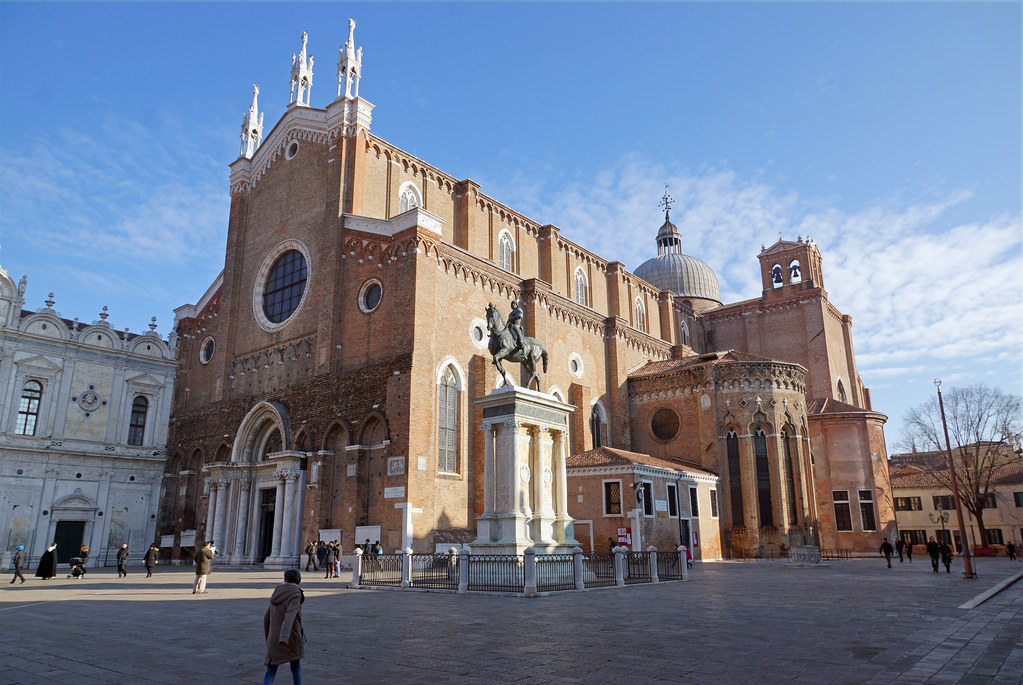
Santi Giovanni e Paolo is one of the largest works of Gothic Architecture within Venice. The church bears a striking resemblance to a few others within the city, but it’s the Byzantine Style dome that sets it apart. Santi Giovanni e Paolo is one of the best examples of the Eastern and Western influences within Venetian Gothic Architecture. Just outside the church is a very famous equestrian statue of Bartolomeo Colleoni. Colleoni was one of the greatest generals of the Venetian Republic. He died in 1475, and his body was moved to a massive Renaissance Style Mausoleum located within the Italian city of Bergamo.
7. Ca’ Foscari
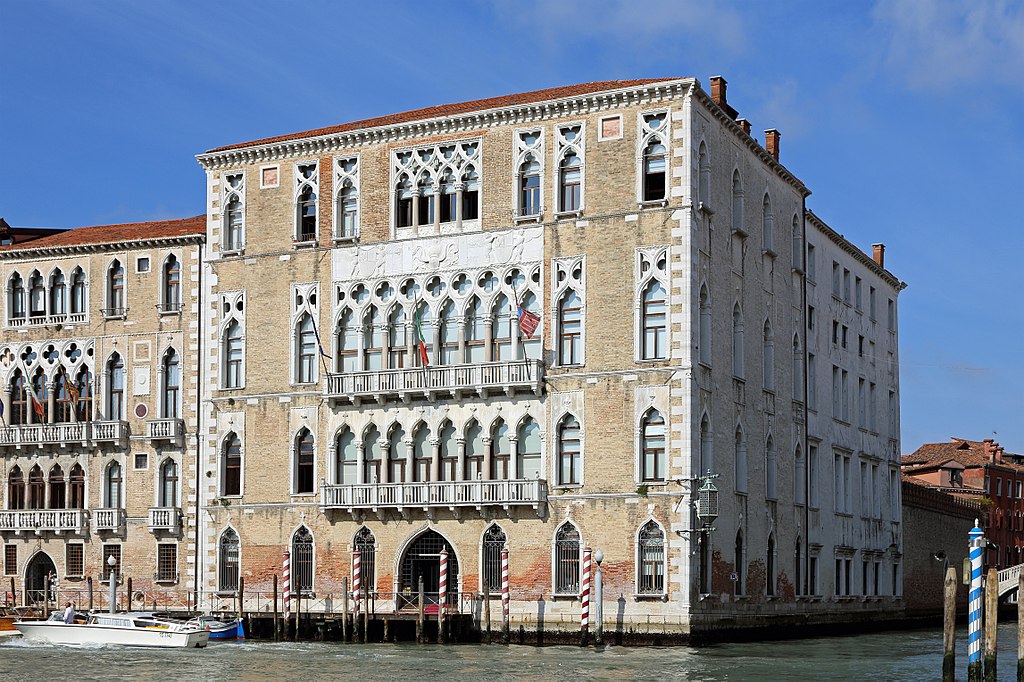
The Ca’ Foscari is another large Venetian Gothic Palace located within Venice. It was built by a member of the powerful Foscari Family. Francesco Foscari commissioned the construction in 1453, at which point he was ruling as the Doge of Venice. Just like many other palaces of the Gothic, Renaissance, and Baroque eras, it was built overlooking the Grand Canal – Venice’s most popular thoroughfare. The palace is also unique because it is located on a corner lot, so there is an additional facade overlooking the Rio de Ca’ Foscari. To get a better sense of the building’s positioning, you can check out this Google Photo Sphere.
8. Palazzo Cavalli-Franchetti
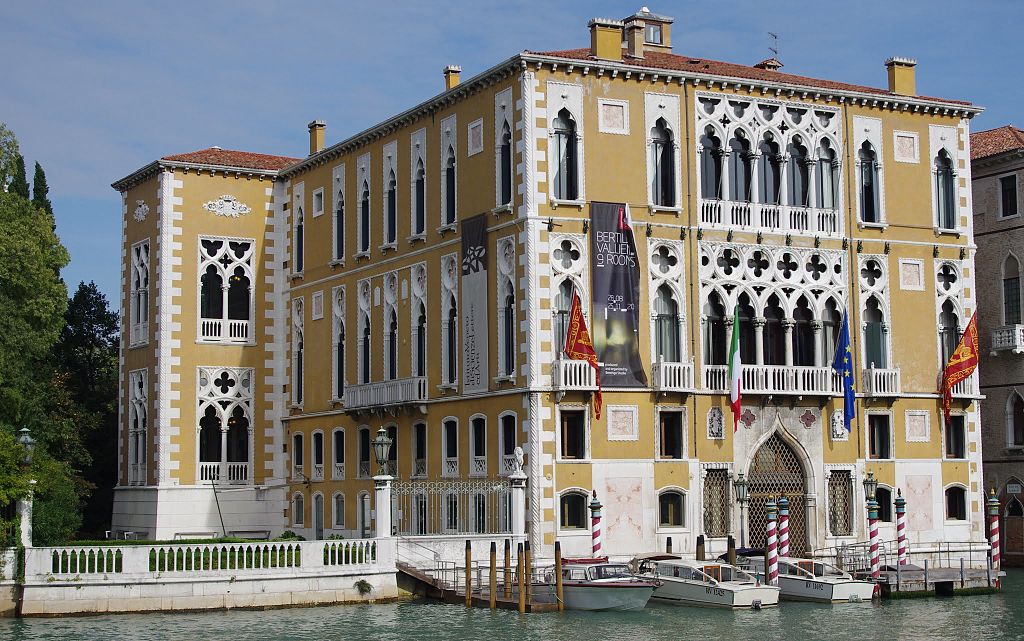
Palazzo Cavalli-Franchetti was completed in 1565, and its a great example of Venetian Gothic Architecture. However, most of the Gothic elements and detailing were actually added to the palace much later in the 19th century. There were a few wealthy owners of the building who made significant modifications in what is considered Gothic Revival or Neo-Gothic Architecture. Today the Palazzo Cavalli-Franchetti is used as an exhibition and event space, and it’s located right next to one of the four crossing points of the Grand Canal, a wooden bridge called the Ponte dell’Accademia.
9. Campo San Polo
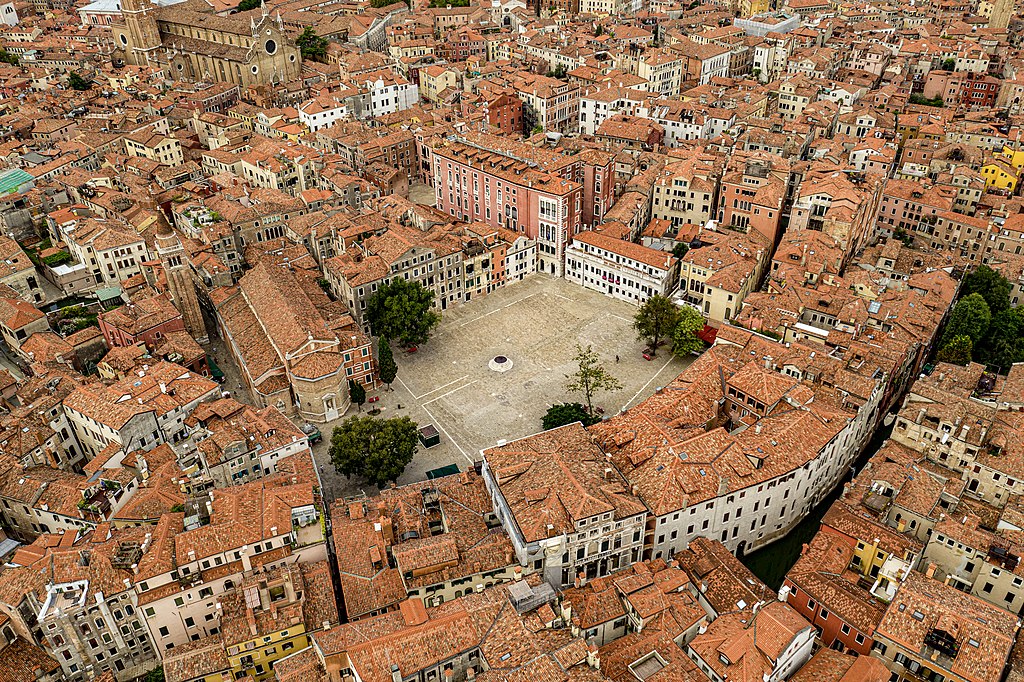
Another quaint public square or Piazza within the city of Venice is Campo di San Polo. Many public squares like this were vital because they contained a water collection system. In the image above, at the center of the piazza, you can see a well. This stored the collected rainwater and provided fresh water to the people living nearby. Campo di San Polo is also lined with Medieval Era buildings, many of them built in the Venetian Gothic Style including the Chiesa Rettoriale di San Polo. Although small, the church is a frequent stop for art enthusiasts. It contains several important paintings from Venetian masters like Tintoretto and Tiepolo.
10. Palazzo Pisani Moretta
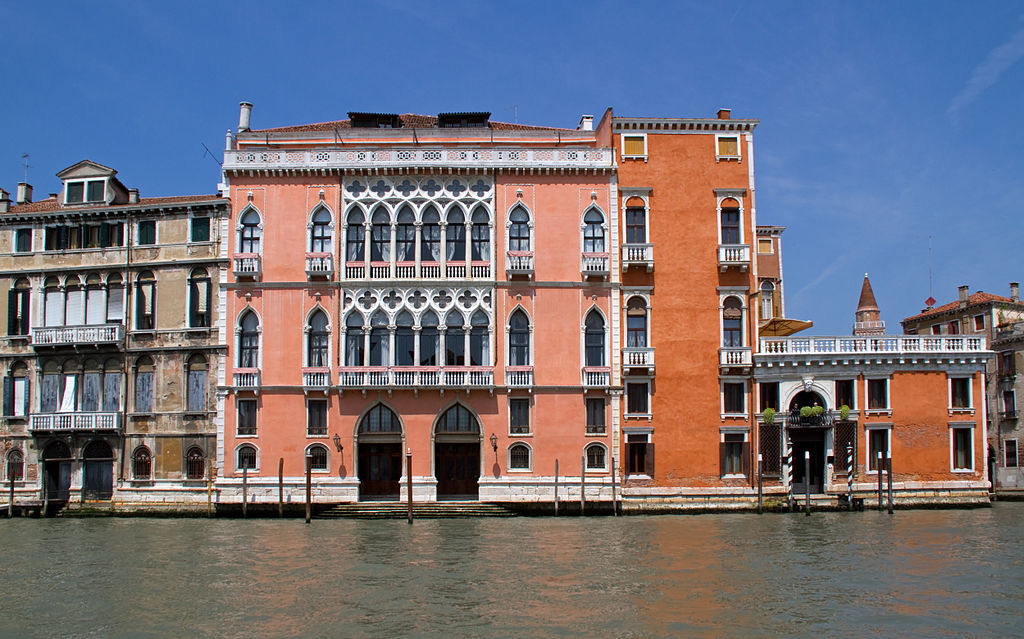
Palazzo Pisani Moretta is a residence built by the wealthy Bembo Family overlooking the Grand Canal. The Bembo Family also built the Palazzo Bembo, which is a very similar-looking building. Both are built in the Venetian Gothic style and date from the 1400s. Within the palace, there is a series of elaborately decorated rooms containing precious works of art. There are a few paintings by Tiepolo, one of Venice’s finest Painters.
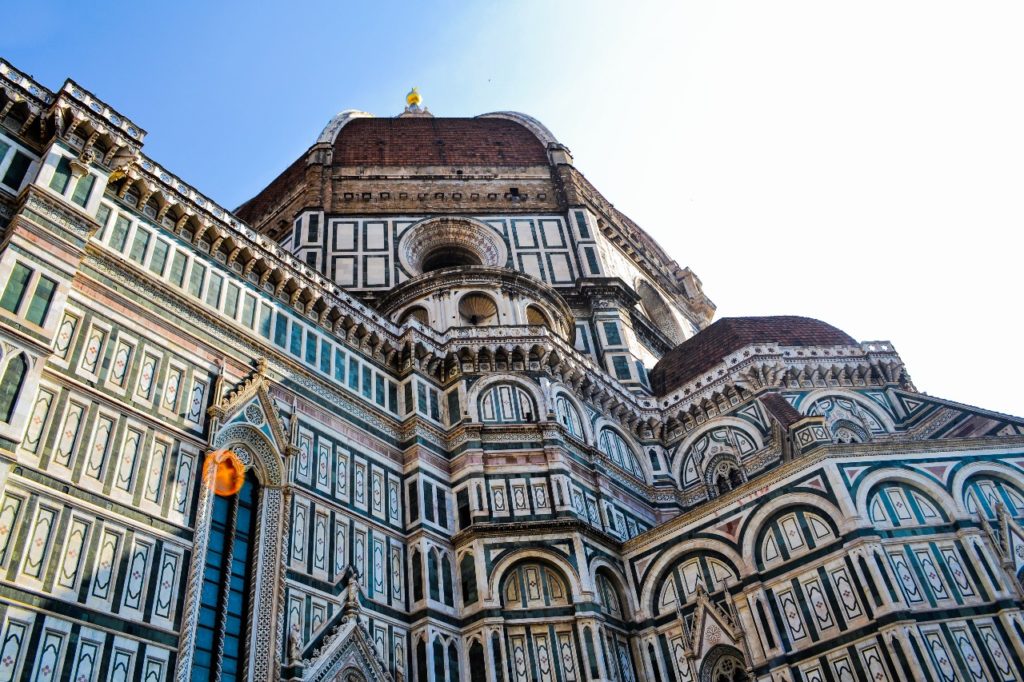
Interested in Renaissance Architecture? Check out our article on the Architecture of Florence to learn more about the Birth of the Renaissance Movement.
Like Architecture of Cities? Sign up for our mailing list to get updates on our latest articles and other information related to Architectural History.
Venetian Renaissance Achitecture
The Renaissance Movement was born in the Italian city of Florence in the early 1400s. The movement quickly spread out of Florence and on to other Italian cities like Rome and Venice. The Republic of Venice continually peaked for much of the Renaissance Period, and it achieved its greatest territorial extent at this time. The trading network of the Venetians continued to create vast amounts of wealth, and the city spent a fortune creating impressive Renaissance buildings. Most notably there was a large expansion of the San Marco neighborhood, and the Piazzo San Marco and St. Mark’s Componile were both completed. However, a new power was emerging in the East that would threaten Venetian Dominance in the eastern Mediterranean. The Ottoman Empire, which would conquer Constantinople in 1453 and bring an end to the Byzantine Empire, would eventually take several of Venice’s maritime holdings, such as Cyprus, Crete, and parts of Greece.
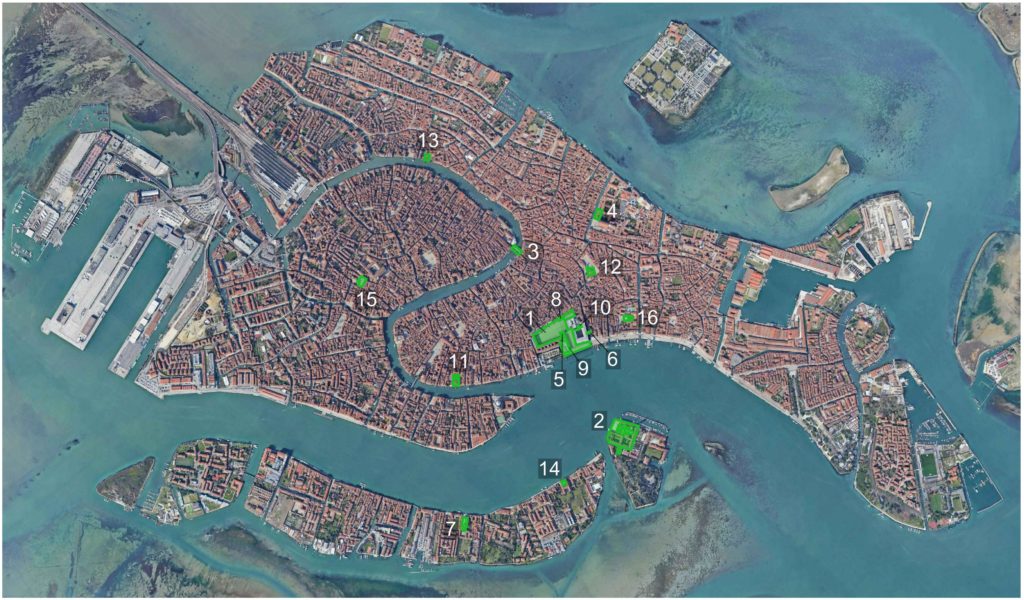
Map of Venice highlighting the most notable works of Renaissance Architecture within the city.
1. Piazza San Marco

Named for the patron saint of Venice, Piazza San Marco is the largest square within the city and it’s among the most famous piazzas in all of Italy. The rhythmic facades that front the square each share the same heights and proportions, which give them a consistent appearance. This was a technique used throughout the Renaissance era. The unity, symmetry, and repetition are all distinct elements of the Renaissance Style. The plan of the piazza is also not perfectly rectangular, and there is a forced perspective that emphasizes the views within the piazza.
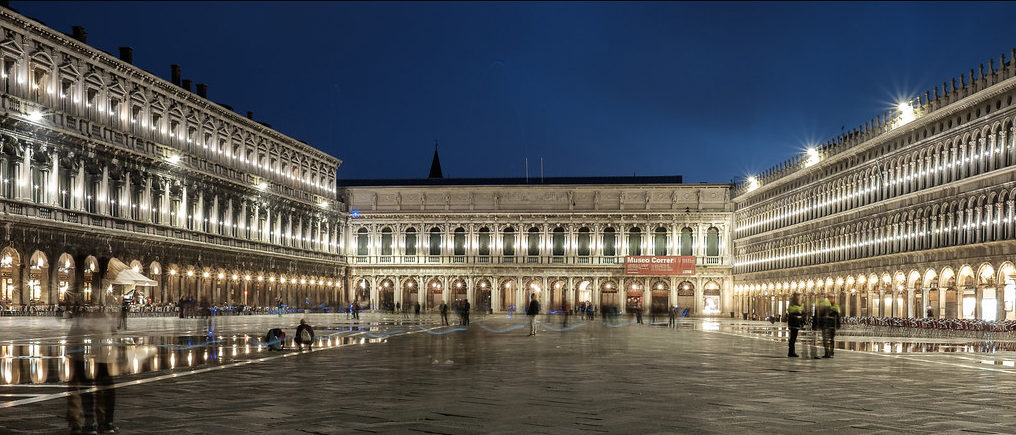
Several of the greatest works of architecture within Venice are located surrounding the Piazza San Marco, including the Doge’s Palace, St. Mark’s Basilica, St. Mark’s Campanile, St Mark’s Clocktower the Biblioteca Marcian. Piazza San Marco is also one of the most lively places in all of Venice. The buildings are all lined with cafes and restaurants, and many people enjoy sitting in the chairs for a relaxing drink, and an incredible view. Piazza San Marco has been the cultural, political, and religious center of the city for more than 1000 years, and today no visit to Venice is complete without a visit to this popular square.
2. San Giorgio Monastery

Venice is home to several of the world’s greatest examples of Renaissance Architecture. The main church within the San Giorgio Monastery is one of the largest within Venice, and it was designed by renowned Renaissance Architect Andrea Palladio. [The church is currently ranked as #10 on our list of the Greatest Examples of Renaissance Architecture] Andrea Palladio was one of the most influential architects of the Renaissance, and he worked mostly in Venice and the surrounding Veneto Region. The church is built with many of the distinct characteristics of Renaissance Architecture, including a white marble facade that resembles a Roman Temple. There are Triangular Pediments, Classical Columns, and marble statues decorating several different niches.
3. Rialto Bridge
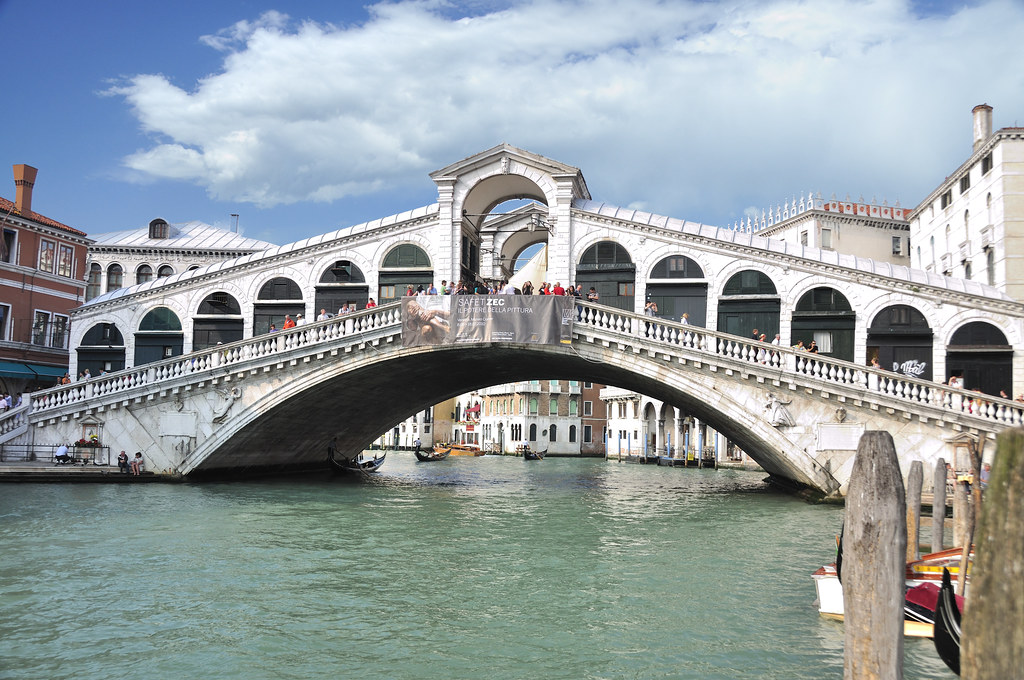
The Rialto Bridge is one of the most iconic bridges in all of Europe, and it’s an incredible work of Renaissance Architecture in Venice. The bridge is one of only four crossing points over the Grand Canal that cuts through the center of the city. A bridge has been at this location since the 12th century, but the current version was built from 1588-1591. It was designed by the architect Antonia da Ponte, and it features a single-span arch that is not only beautiful but also functional as it creates a large space for the Grand Canal’s busy boat traffic. The walkway is topped with a covered archway that protects pedestrians from the sun and the rain.
4. Scuola Grande di San Marco
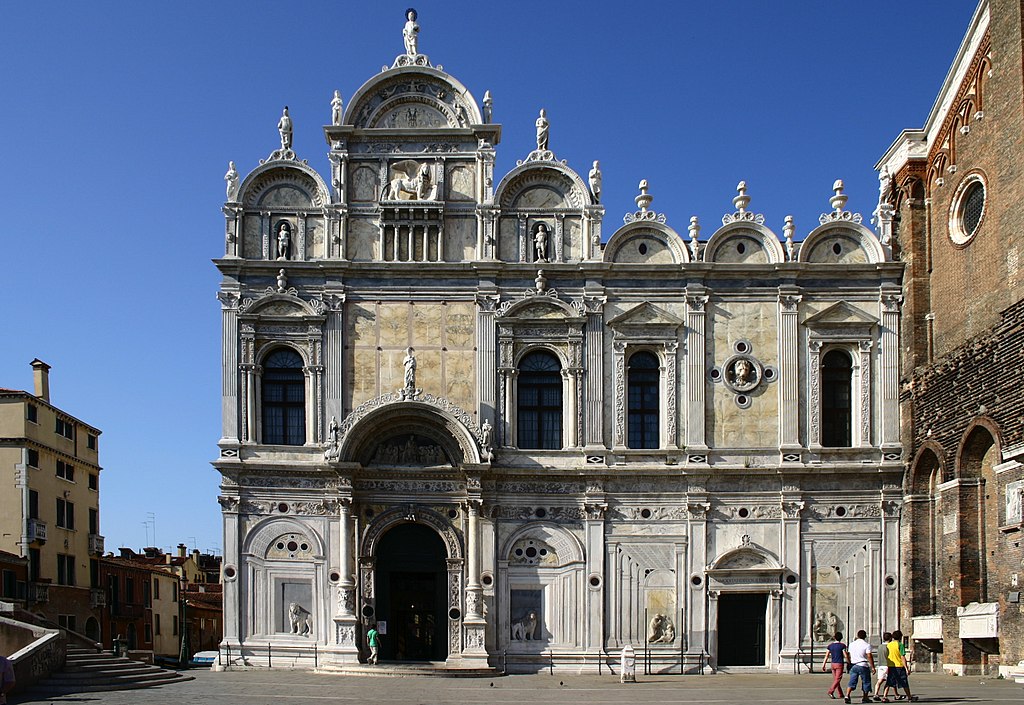
One of Venice’s oldest Renaissance churches is the Scuola Grande di San Marco. It was built in the late 1400s, during the early days of the Renaissance Movement in Venice. The main facade is completely decorated with marble and features all of the typical elements of Renaissance Architecture. There are round arches, pediments, and other classical details like marble statues and Corinthian columns. The facade also has a slight Byzantine influence, with a lot of the detailing resembling the main facade of St. Mark’s Basilica. The lowest portion of the front elevation is decorated with 3D perspective drawings, which are designed to make it look like the facade has more depth.
5. St. Mark’s Campanile
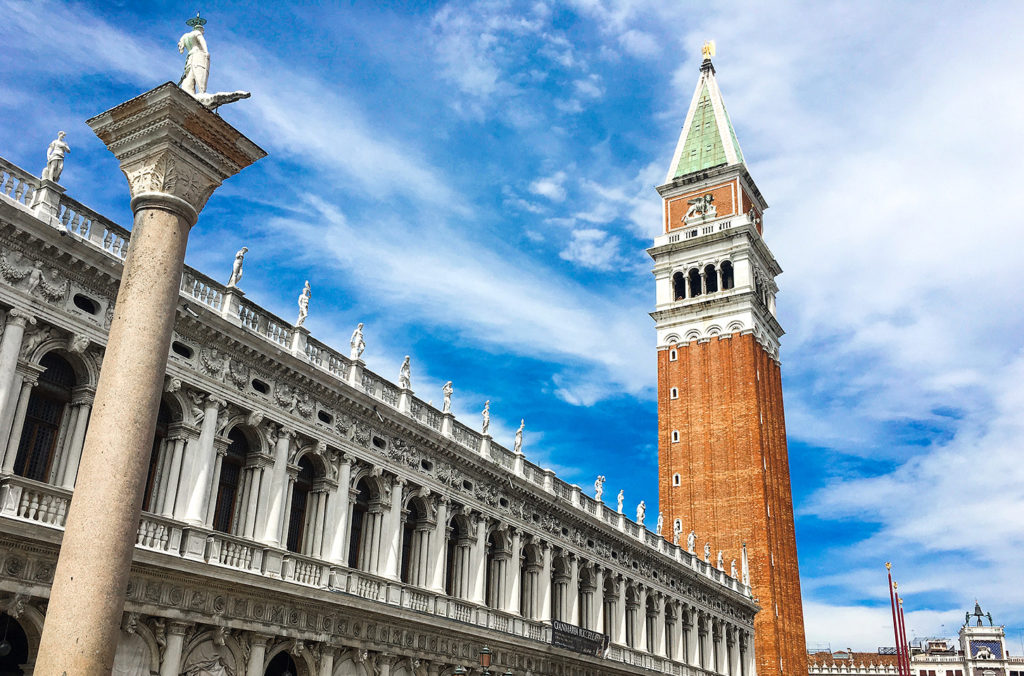
St. Mark, the patron saint of Venice, is whom St. Mark’s Campanile is named for. St. Mark was an early follower of Christianity, and he was responsible for spreading the religion throughout the Mediterranean. He famously founded the Church of Alexandria and wrote the Gospel of Mark. The tower itself was originally completed in 1514, when it was capped with a viewing platform and a pitched roof built in the Renaissance Style. The original tower collapsed in 1902 and was subsequently replaced. The tower that stands today is a reproduction that was completed in 1912. Because it was rebuilt, St. Mark’s Campanile contains a modern-day elevator that brings visitors to the top so they can enjoy incredible views of the entire city of Venice.
6. Bridge of Sighs
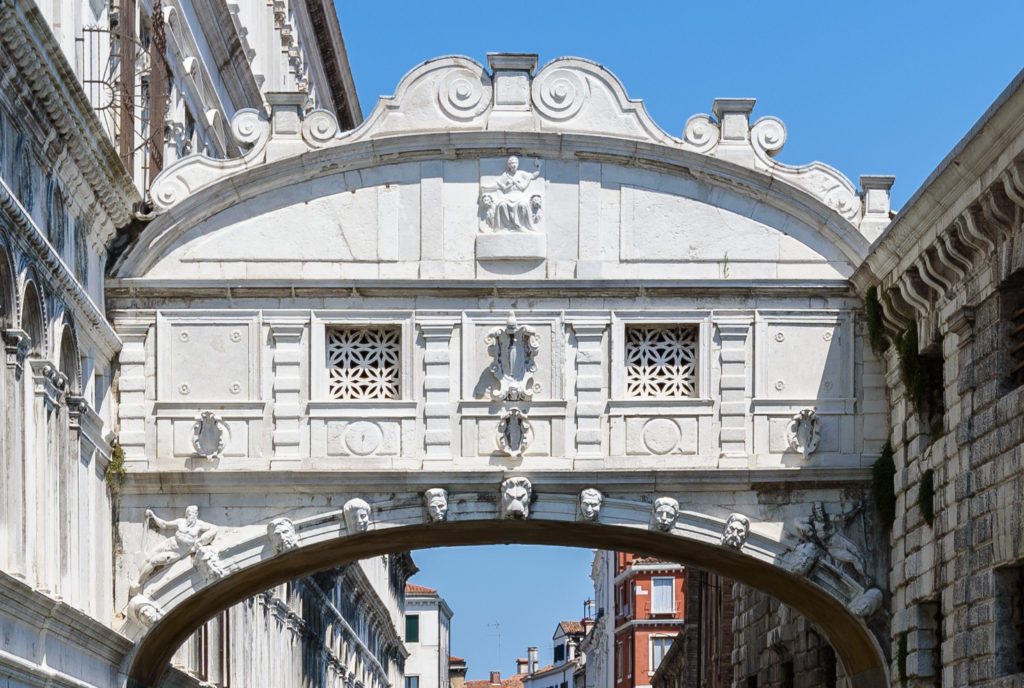
The Bridge of Sighs is another great example of Renaissance Architecture in Venice. It was built in the year 1600, and it was meant to connect the Doge’s Palace with a nearby prison. Criminals would be interrogated and sentenced in the chambers of the Doge’s Palace, and they would then cross over a canal via the bridge on their way to serve their sentences. As individuals would cross the bridge, they would look out one final time through the windows at the beauty of Venice. They would then sigh, saddened by the fact they would be locked away and unable to live and enjoy the incredible city around them.
7. Il Redentore
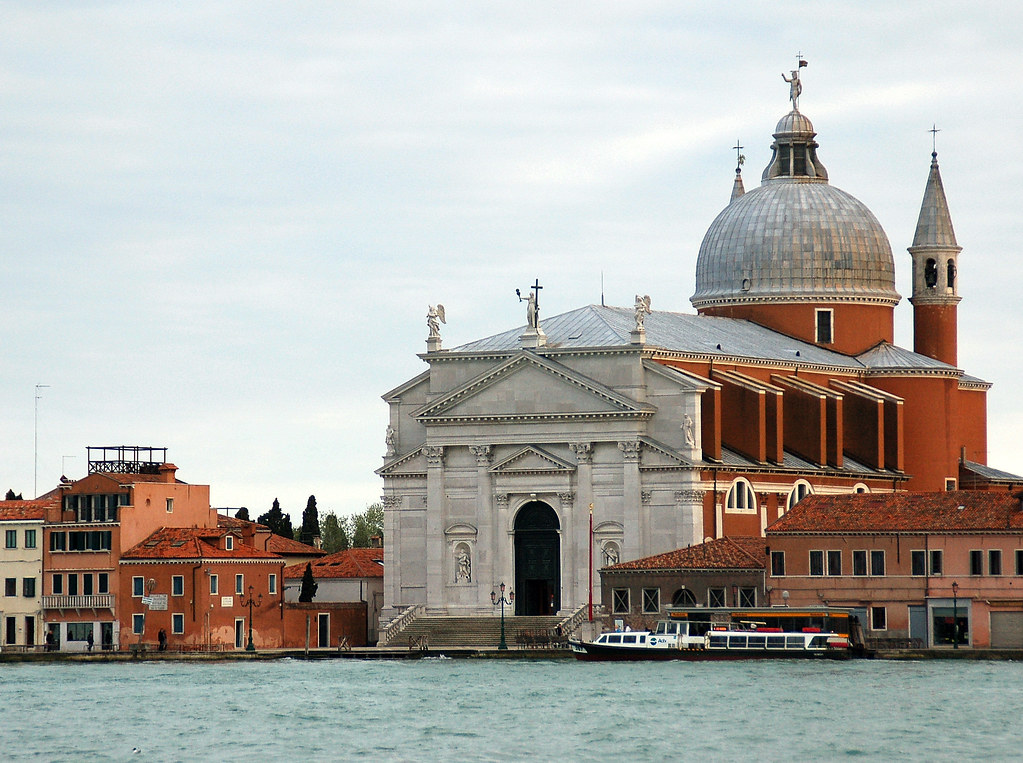
Il Redentore is another Renaissance Style Church in Venice that’s designed by Andrea Palladio. The church has an imposing position overlooking the Giudecca Canal – a wide waterway separating the main part of Venice from the Island of Giudecca. Il Redentore was completed in 1592, and it is has a very similar appearance to another Palladian building, the San Giorgio Monastery. Both were constructed simultaneously in the late 1500s, with the Monastery of San Giorgio finishing up 18 years after Il Redetore in 1610.
8. St Mark’s Clocktower
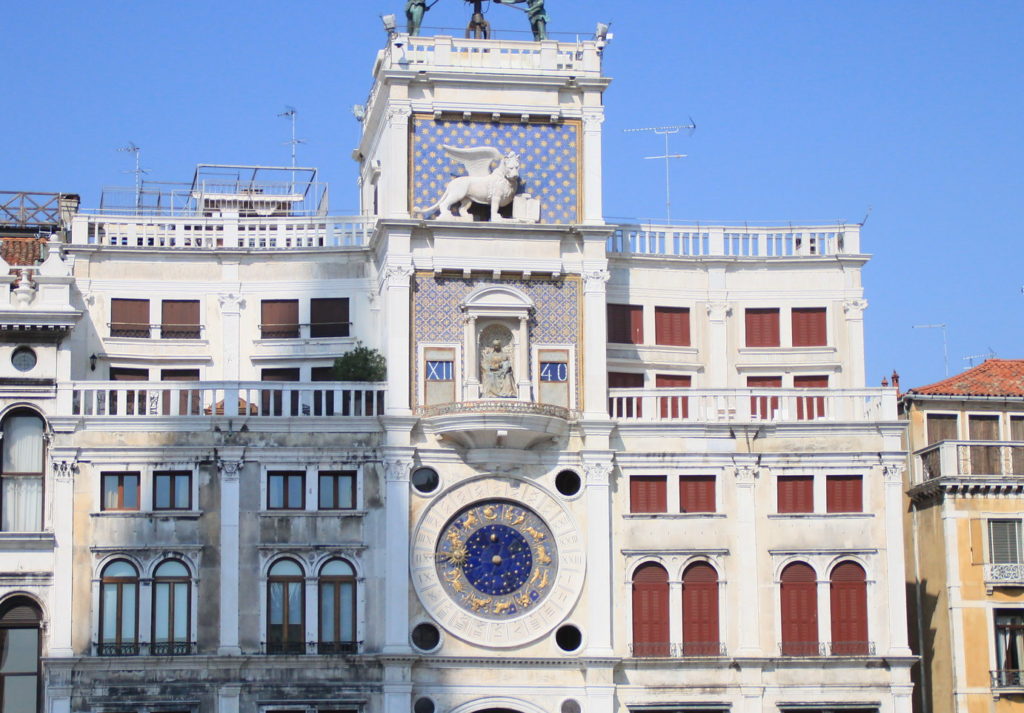
St Mark’s Clocktower is one of Europe’s greatest Astronomical Clocks, rivaling others such as the Prague Astronomical Clock. Astronomical clocks give other information besides the time, including the phases of the moon, and the Zodiac Callendar. These clocks were very popular in the late Middle Ages and dozens of cities throughout Europe feature these complicated pieces of Medieval Machinery. The tower containing the clock is dedicated to Saint Mark. At the top, you can see a winged Venetian Lion which was a symbol of Saint Mark before being adopted as the official seal of Venice.
9. Biblioteca Marciana
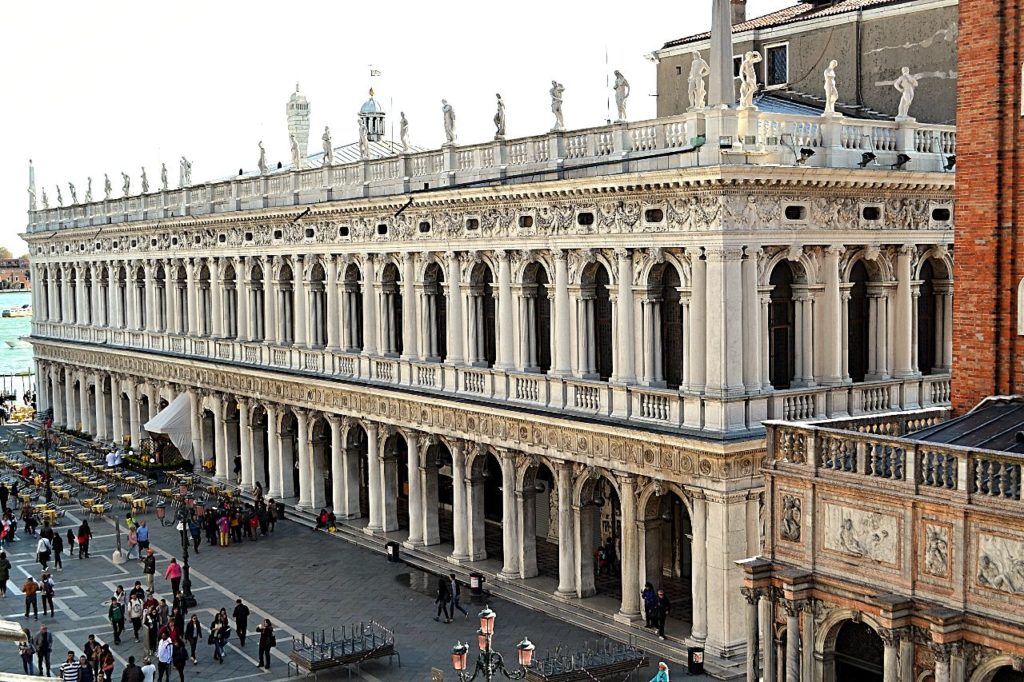
The Biblioteca Marciana, also known as the Library of St. Mark, is a Renaissance building located directly across from the Doge’s Palace within Piazza San Marco. Construction began on the building in 1537, and the use of classical design elements can easily be seen throughout the exterior. There are white marble statues adorning the roof and there are Doric and Ionic columns, paired with round arches throughout the facade. The Biblioteca Marciana once contained a great collection of books, manuscripts, and historical documents. But most of these have since been moved to other locations and today the library mostly functions as a museum.
10. Additions to the Doge’s Palace
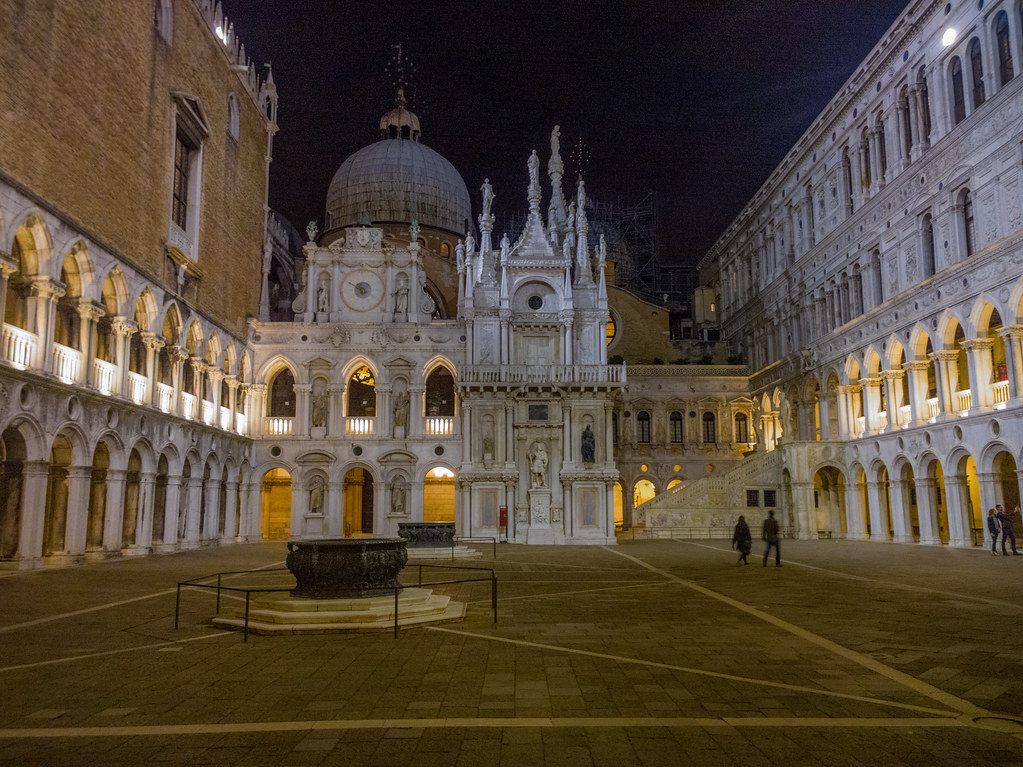
The Doge’s Palace, which is primarily a Gothic Building, also contains a few Renaissance Elements throughout. In the image above you can see the courtyard of the palace, which features a large monumental staircase that was built in 1485. The steps were nicknamed, “The Giant’s Staircase,” and they created an easy access point connecting the interior of the Doge’s Palace, with the rest of the buildings in the Piazza San Marco area. Within the Doge’s Palace, you will also find numerous examples of Renaissance artwork, including masterpieces by Giovanni Bellini and Titian.
11. Palazzo Corner della Ca’ Grande
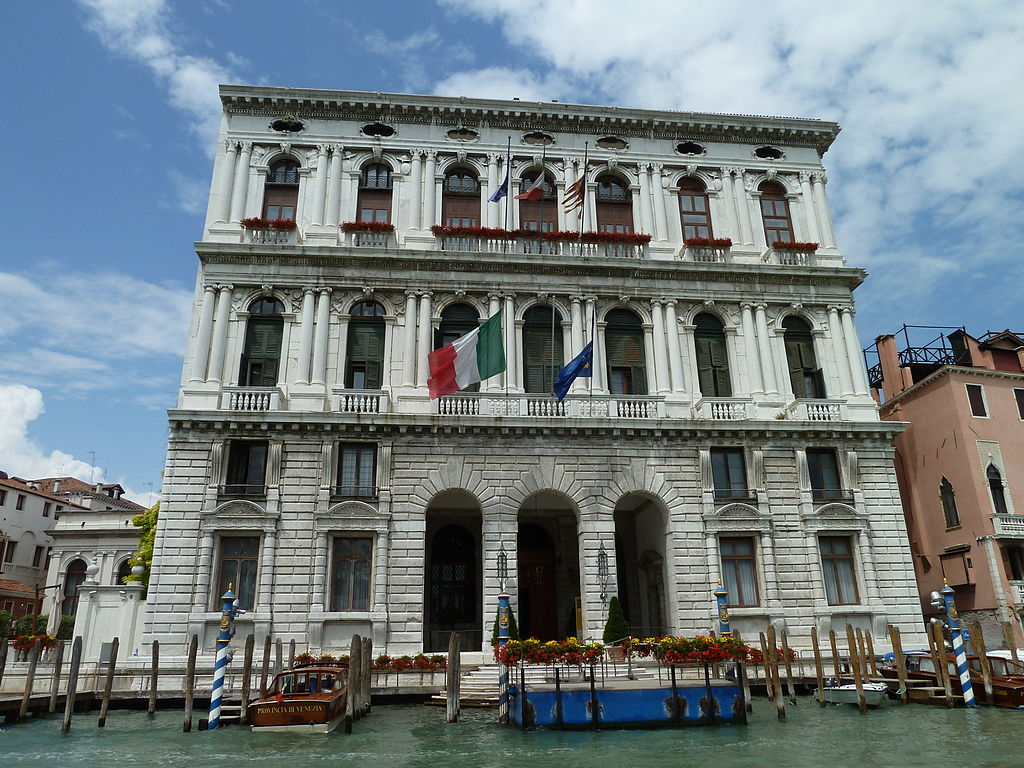
Because of the incredible wealth brought into the city by its vast trading network, Venice had one of the wealthiest populations in all of Europe. As a result, the city is filled with dozens of great palaces. Many of which line the Grand Canal. The Palazzo Corner della Ca’ Grande is one of these many palaces. Unlike some of the other Gothic Palaces on this list, the Palazzo Corner is built entirely in the Renaissance Style. The main facade features all of the typical elements from Renaissance Architecture, such as symmetry, proportion, repetition, and orderliness.
12. Santa Maria Formosa

Santa Maria Formosa is a Renaissance Style Church located in the heart of Venice’s historic center. The church is impressive for its size and it towers over the surrounding Campo di Santa Maria Formosa. The church was completed in 1492, at a time when Renaissance Architecture was really gaining popularity in Venice. It features a classic Venetian Bell Tower, which was a staple of many different Venetian Cities. All of these towers are built in a square plan, are extremely narrow and thin, and are capped with a steeply pitched roof.
13. Palazzo Vendramin
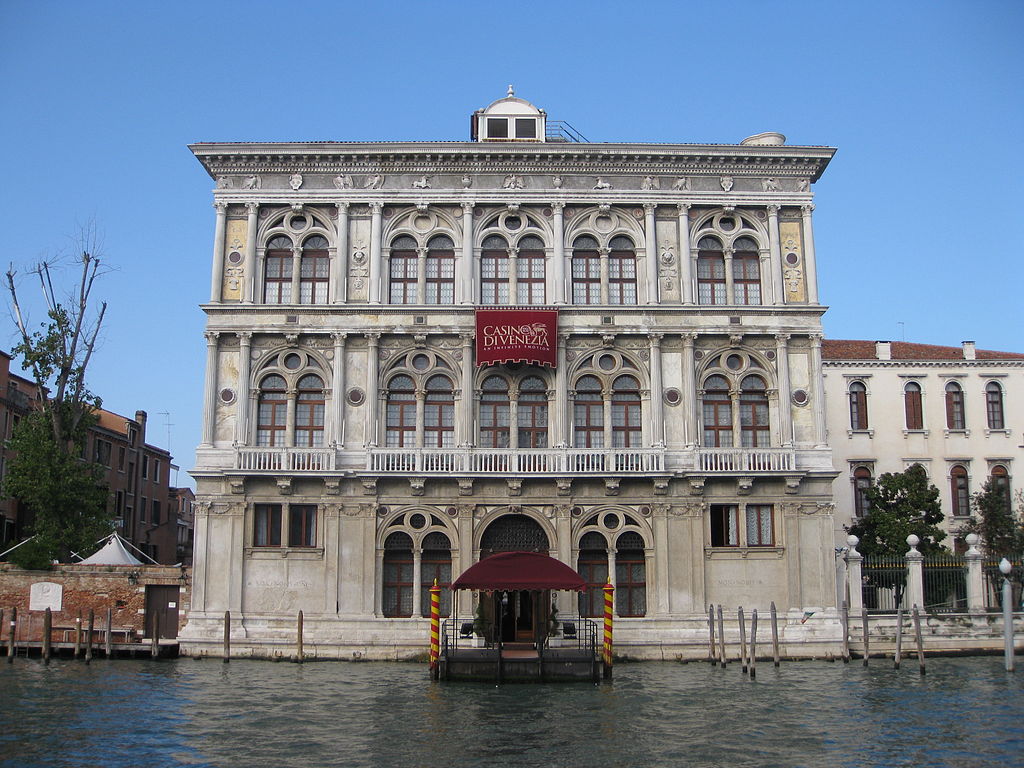
Palazzo Vendramin, also known as Ca’ Vendramin Calergi, is another lavish residence built on the edges of the Grand Canal. It was built in the year 1481, and it’s one of the best examples of Renaissance Architecture anywhere in Venice. The main facade is symmetrical and borrows many of its features from Classical Architecture, such as the Ionic Columns and the decorative frieze at the top. Today the Palazzo Vendramin is well known as the home of the Casino de Venezia. The casino has been located in the palace since the 1950s and it is a popular spot for gambling and nightlife within Venice.
14. Le Zitelle
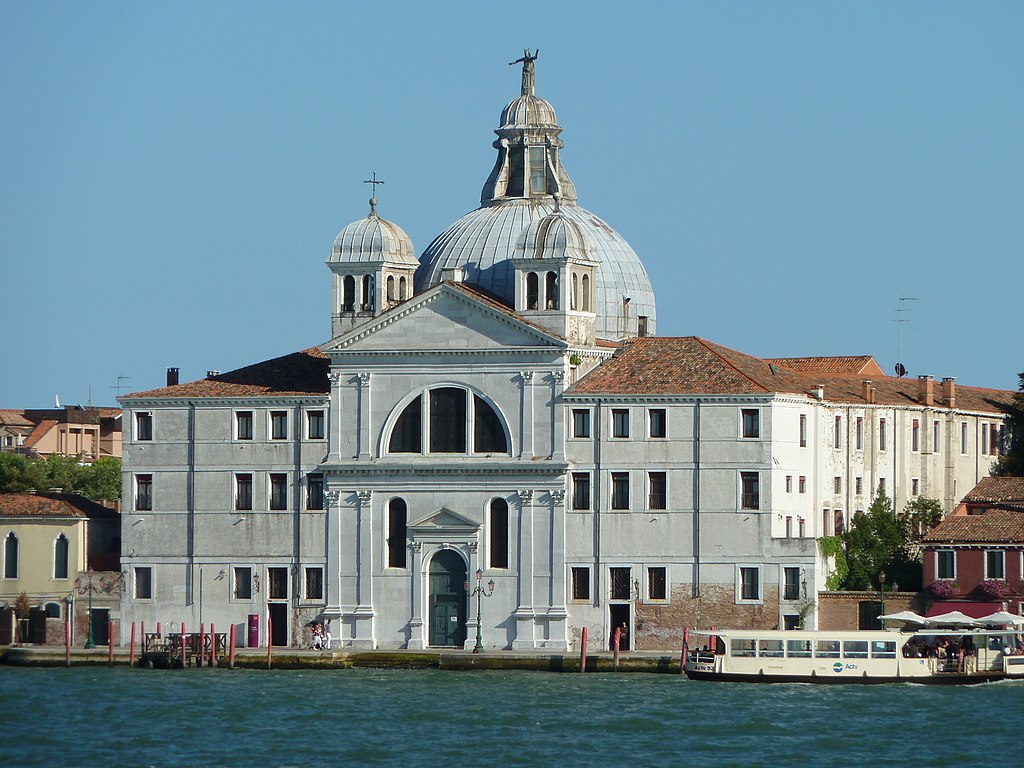
Le Zitelle is another church located not far from Il Redentore, on the island of Giudecca. Its also known as the Chiesa di Santa Maria della Presentazione, but many of Venice’s churches are referred to by shorter nicknames. The church has a fantastic position overlooking the Giudecca Canal and many believe it was designed by Andrea Palladio, who also designed several other churches in this part of Venice. Together these churches show just how productive Palladio was during the Renaissance, rivaling other artists like Brunelleschi and Michelangelo who designed many incredible buildings in Florence and Rome.
15. Scuola Grande di San Rocco

The Scuola Grande di San Rocco, which translates to the Great School of Saint Roch, is an impressive Renaissance building located right next to the Church of Saint Rocco. Most people visit the building to view the many paintings by Venetian Renaissance Master Tintoretto. Tintoretto was born in 1518 in Venice, and he eventually became one of the most successful artists in town. He painted the interiors of dozens of buildings and palaces throughout Venice, and one of his most impressive works is the Il Paradiso painting within the Doge’s Palace.
16. San Zaccaria

San Zaccaria is a large Renaissance Style Church located within the San Marco neighborhood. It features a marble-clad facade, which is decorated in a typical Renaissance fashion. Here you can see the use of Classical Architectural Elements, paired with a harmonious use of symmetry and proportion. The church was completed in the 15th century, and it is built with pristine white Istrian Marble – a material that can be found throughout many works from the Venetian Renaissance.

Interested in Revival Architecture? Check out our article on the Architecture of Stockholm to see more great examples of Revival Style Buildings.
Baroque & Neoclassical Architecture in Venice
The Republic of Venice continued to peak through the start of the Baroque Age, but two major factors lead to its eventual decline. The first was the Discovery of the New World, which lead to a massive shift in European trade, which was now focused on the Americas rather than the Mediterranean. This weakened the Venetian trading network significantly, and lead to a great loss of income. In addition to this, there were continued losses of Venetian territory to the Ottoman Empire. The Ottomans took over Crete in 1699 and pushed the Venetians out of Greece entirely by 1718. Although Venice still contains a lot of Baroque Buildings, at this point in history the city was in a slow state of decline, which would ultimately end with the dissolution of the republic in 1797.
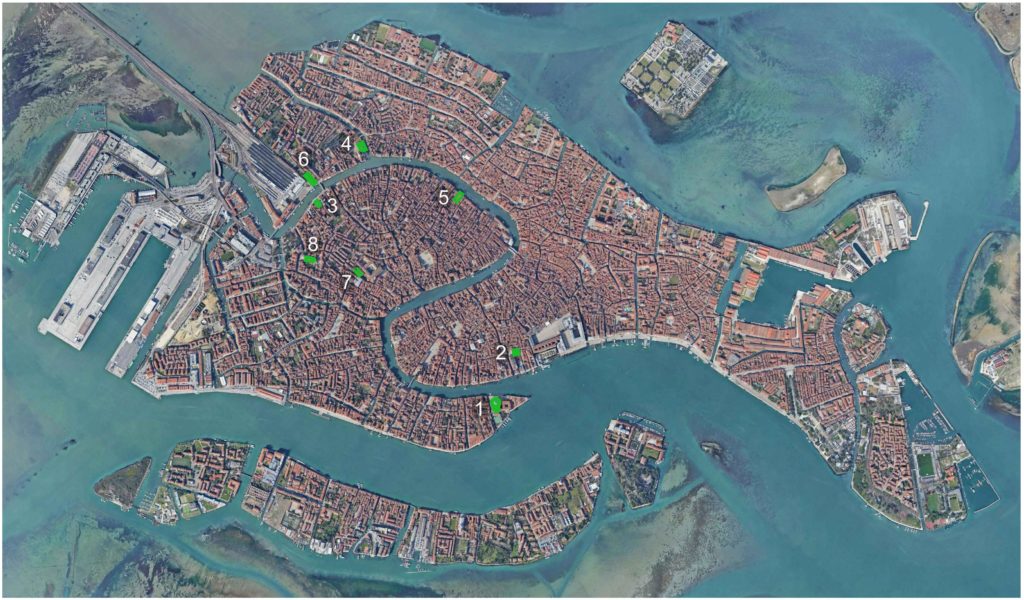
Map of Venice highlighting important works of Baroque and Neoclassical Architecture within the city.
1. Santa Maria della Salute
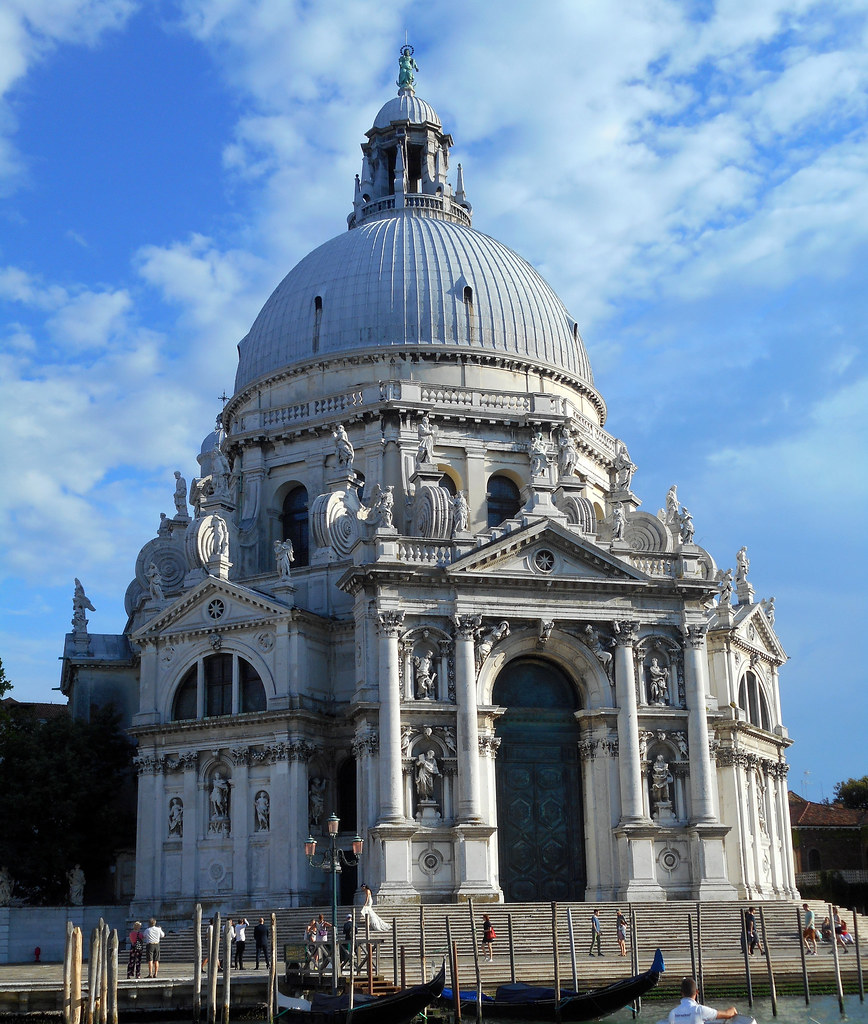
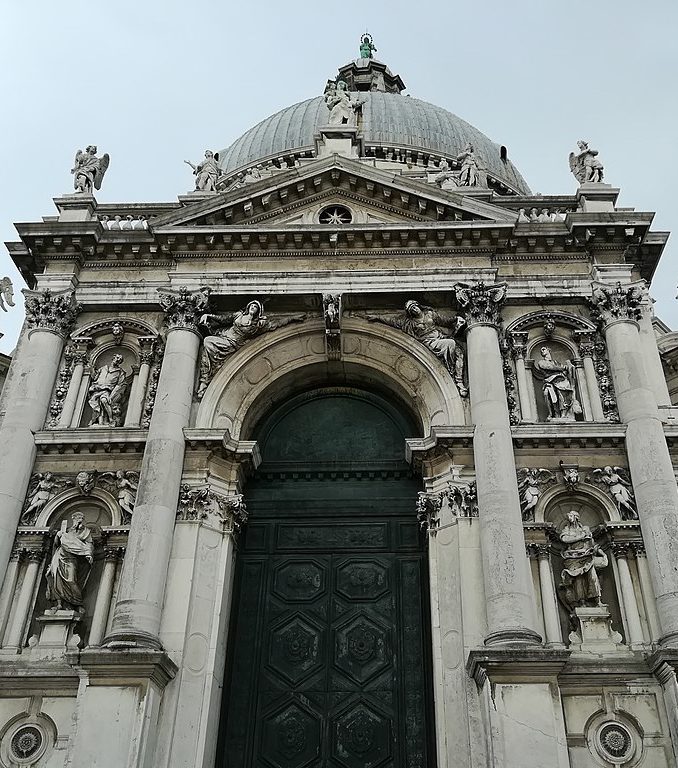
Santa Maria della Salute is by far the most iconic Baroque Church in all of Venice. It sits on a narrow piece of land that separates the Grand Canal from the Giudecca Canal. Work began on the church in 1631, and it incorporates many of the distinct characteristics of Baroque Architecture. The exterior is lavishly decorated with ornately carved details and statues. There are also several elements that have been borrowed from Classical Architecture, such as the Corinthian Columns and the balustrade that sits atop the roofline just below the dome. Most of the exterior is made entirely of the same Istrian Marble that is found throughout Venice.
2. San Moisè

San Moisè is a church in Venice that is dedicated to Moses. It contains one of the most intricate and lavishly decorated facades of any church on this list. Much of the building dates to the Baroque Age, and the main facade was started in 1668. The facade is one of the best examples of the harmony of sculpture and architecture that existed in the Baroque Age. The entire front of the church is covered with sculptures depicting people, plants, and animals, and there are also a few monuments to prominent Venetians.
3. San Simeone Piccolo
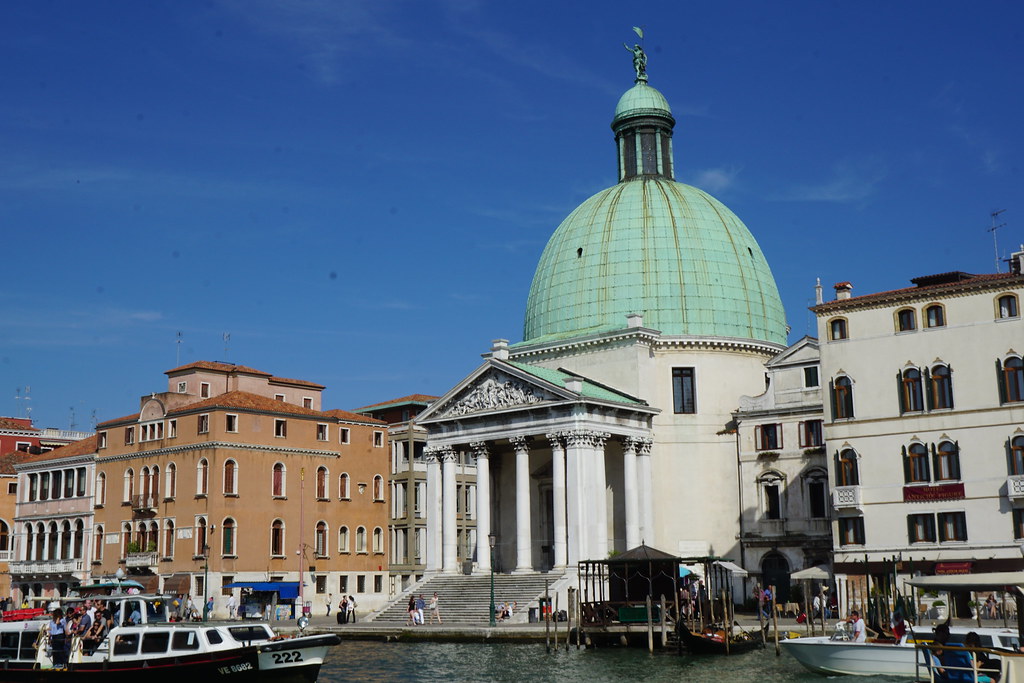
San Simeone Piccolo is a Neoclassical church located in the Santa Croce neighborhood of Venice. It’s often one of the first works of architecture people see when entering Venice because it’s located directly across from the city’s main transport hub – Stazione di Venezia Santa Lucia. The church was built in the early 1700s, making it an early version of the Neoclassical Building Form that would sweep across Europe by the 19th century. The main facade of the building is an almost exact replica of a Roman or Greek-style temple. Neoclassical Architecture would eventually become one of the leading styles during the Revival Era of the 1800s. Countless buildings were built in this style throughout the world, particularly in places like the United States, Russia, and the UK.
4. Palazzo Labia

Palazzo Labia is a work of Baroque architecture located in the Cannaregio neighborhood of Venice. It is one of several important buildings fronting the Campo San Geremia, one of Venice’s larger public squares. Construction on the palace began in the 17th century but many of the final touches on the interior wouldn’t be completed until the 18th century. The interior of Palazzo Labia is filled with several significant works of art. The most iconic of these art pieces is a large frescoed ceiling painted by the Roccoco painter Giovanni Battista Tiepolo.
5. Palazzo Corner della Regina
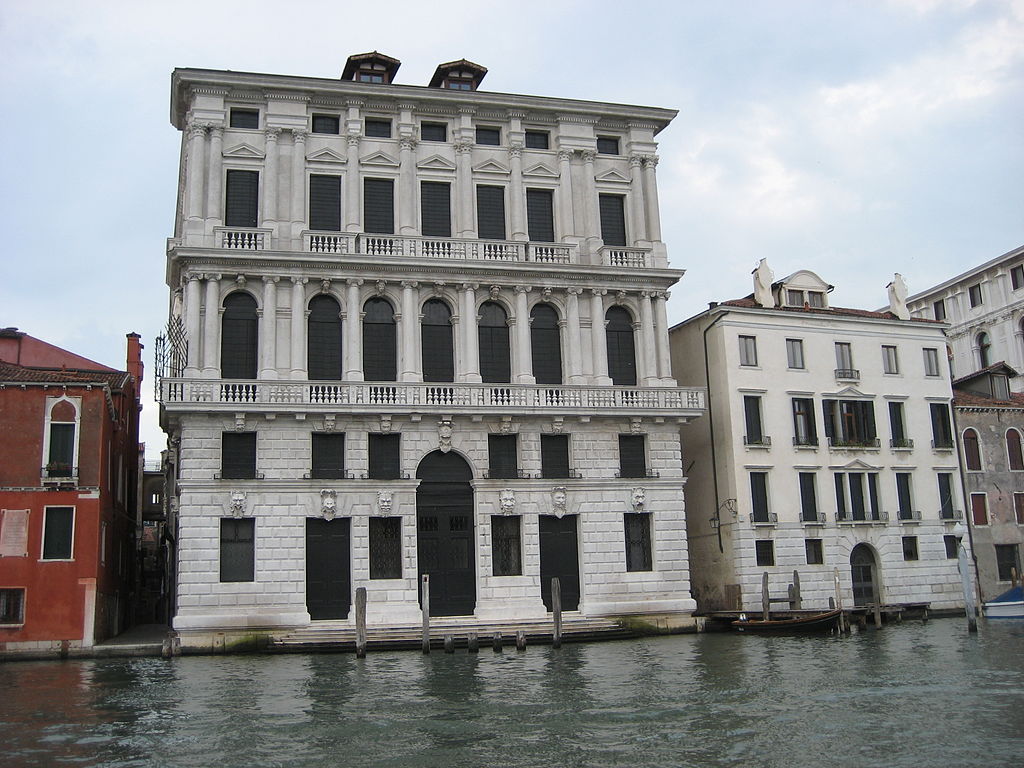
The Palazzo Corner della Regina is one of the last major palaces built along the edges of the Grand Canal. It was constructed beginning in 1724, and its one of the greatest examples of Baroque architecture in Venice. The Facade features many of the typical Baroque Design Elements, but one aspect that makes this building unique is the inclusion of expressive faces above the windows and doorways. These faces, or masks, each convey different emotions, and some of them even function as downspouts. This playful use of imagery and decoration was common in the Baroque Age. One can imagine that the masks on this facade were inspired by the iconic Masquerade Balls that were thrown periodically within Venice during this time period.
6. Chiesa degli Scalzi
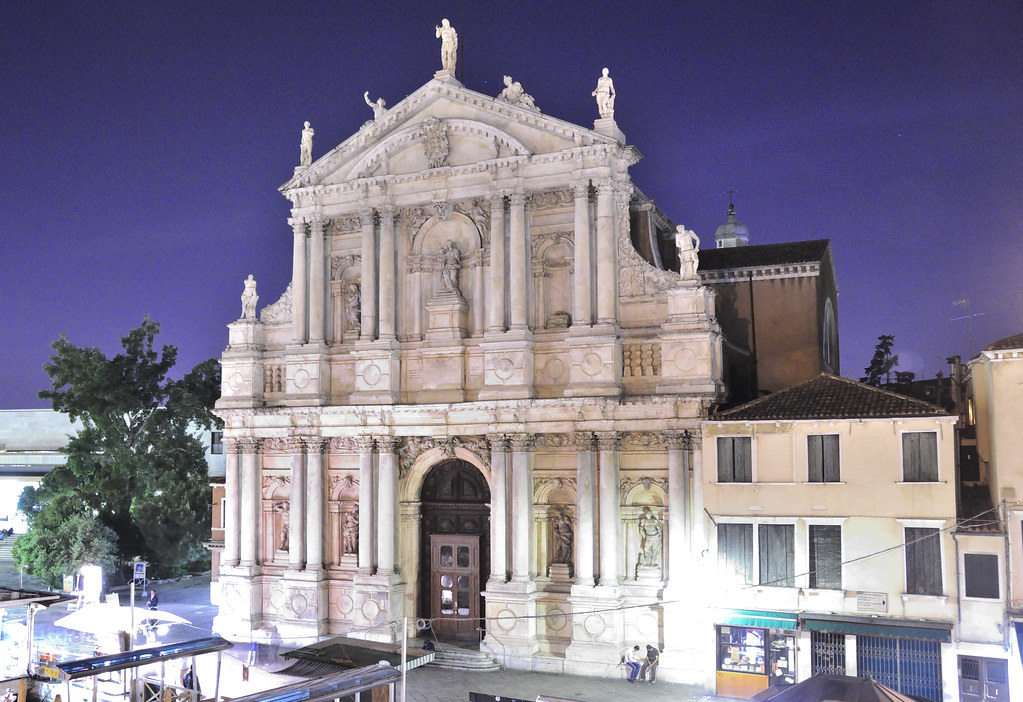
Chiesa degli Scalzi is another important Baroque Church located within Venice. Construction began on the church in the mid 17th century, and it once contained an incredible fresco painted by Tiepolo. However, during WWI the Austrian military launched several air raids on Venice. In 1915, the Chiesa degli Scalzi was heavily damaged by one of these raids, and several works of art, including Tiepolo’s fresco, were lost forever. The Austrian attacks on Venice proved to be of little strategic value during the war and in a way, they were actually a costly mistake. Newspapers in France, the UK, and the United States all reported on the attack, which helped increase support for the war effort in Europe. One newspaper called the Daily Sketch in London had a front-page story entitled, “Autrian’s Drop Bombs on Beautiful Venice.”
7. San Rocco
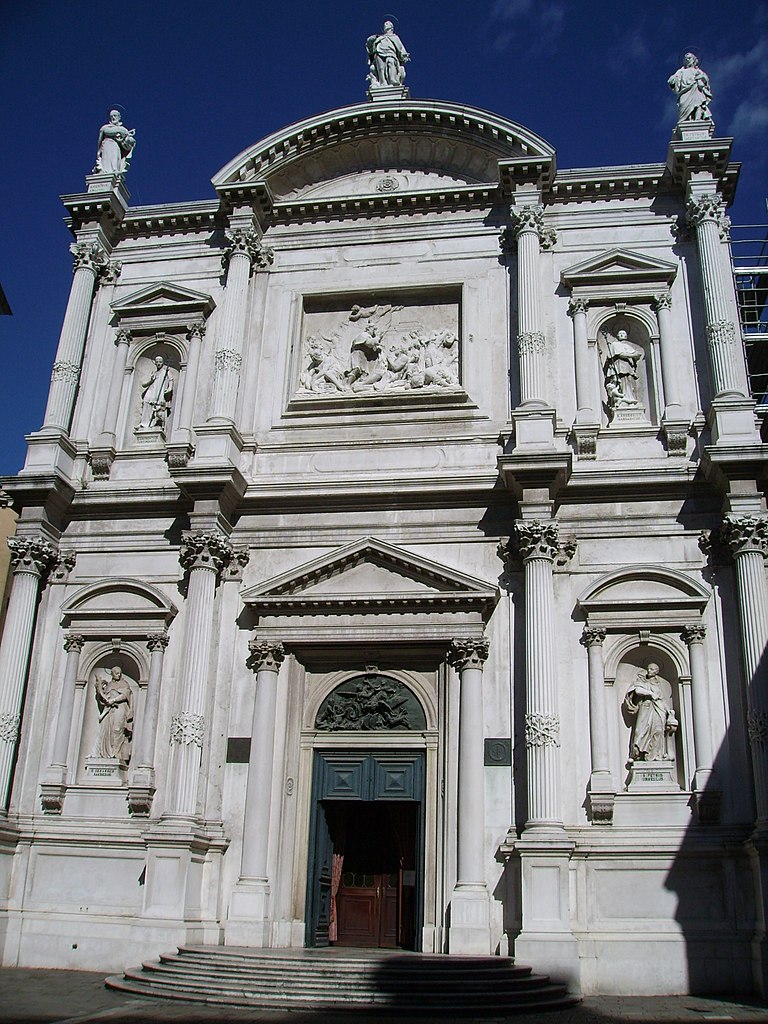
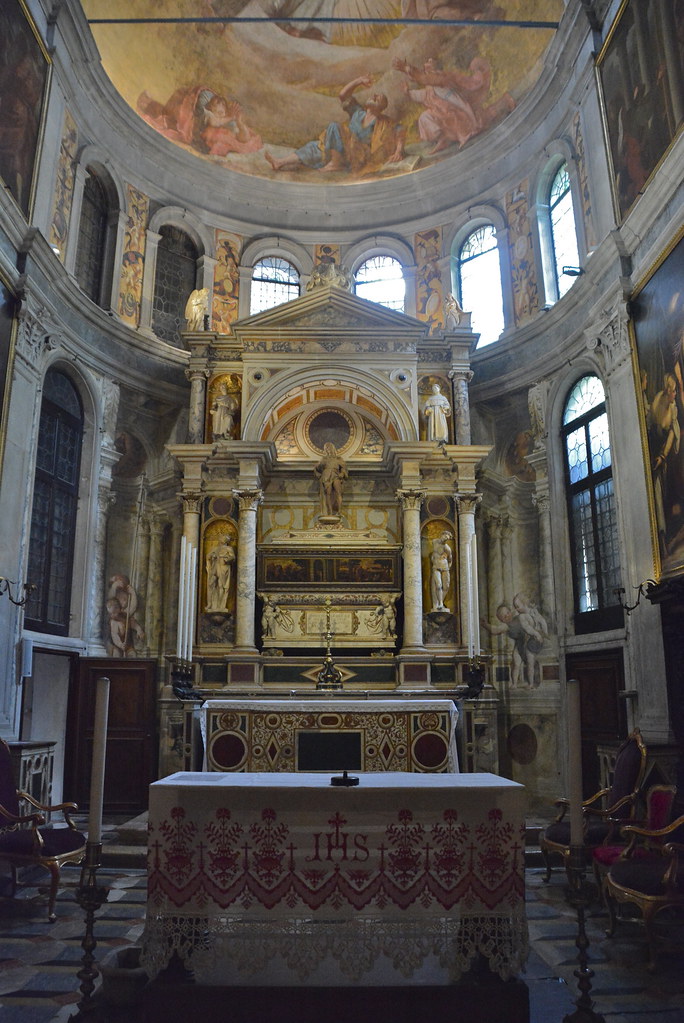
The Church of San Rocco is a religious building located in the heart of Venice and it originally dates to the Italian Renaissance Era. Much of the church was built in the late 1400s, but it saw a major renovation during the Baroque Age. The main facade of San Rocco was begun in 1765, and it contains several major design features of the Baroque Style. The church is located right next to a few other major works of architecture mentioned in this article including the Church of Santa Maria Gloriosa dei Frari and the Scuola Grande di San Rocco.
8. Chiesa di San Nicolò da Tolentino
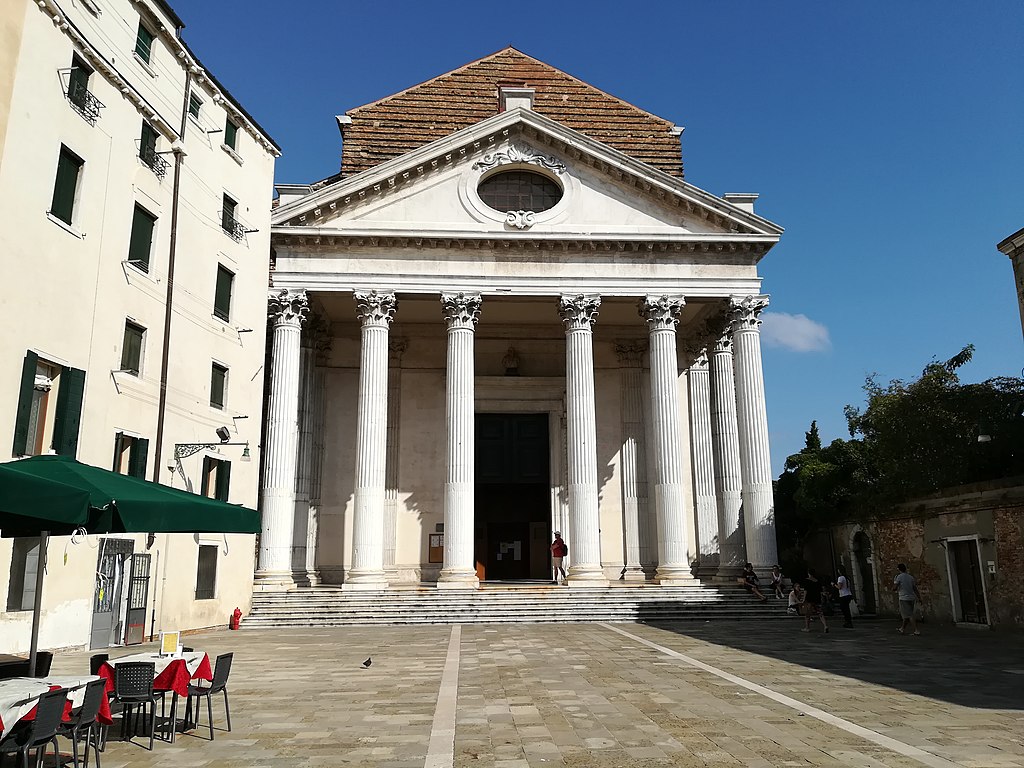
Chiesa di San Nicolò da Tolentino is a church in Venice’s Santa Croce neighborhood. Construction originally began on the church in the late 1500s, but the main portico at the front was added in the Baroque Age. This portion greatly resembles a Greek or Roman Temple, and has a row of six Corinthian Columns supporting a Pediment. The Pediment is decorated with an oval-shaped window, which is an important Baroque detail within the overall facade.
Modern Architecture in Venice
The Republic of Venice was broken up by Napoleon in 1797. The city was then controlled initially by the First French Empire and later by the Austrian Empire. Eventually, Venice joined the Italian Unification Movement in the 1860s and became part of the Kingdom of Italy. Venice made it through both WWI and WWII largely undamaged when compared to other European cities, and today Venice looks about the same as it did when it peaked during the 15th-18th centuries. However, Venice is still home to a few sporadic examples of modern architecture which are nestled between some of the city’s more historic buildings. One of the greatest modern-age architects of Venetian origin is Carlo Scarpa, who spent his entire career designing buildings within the Veneto Region. Venice contains a few cherished Scarpa Buildings, among other works from famous architects.
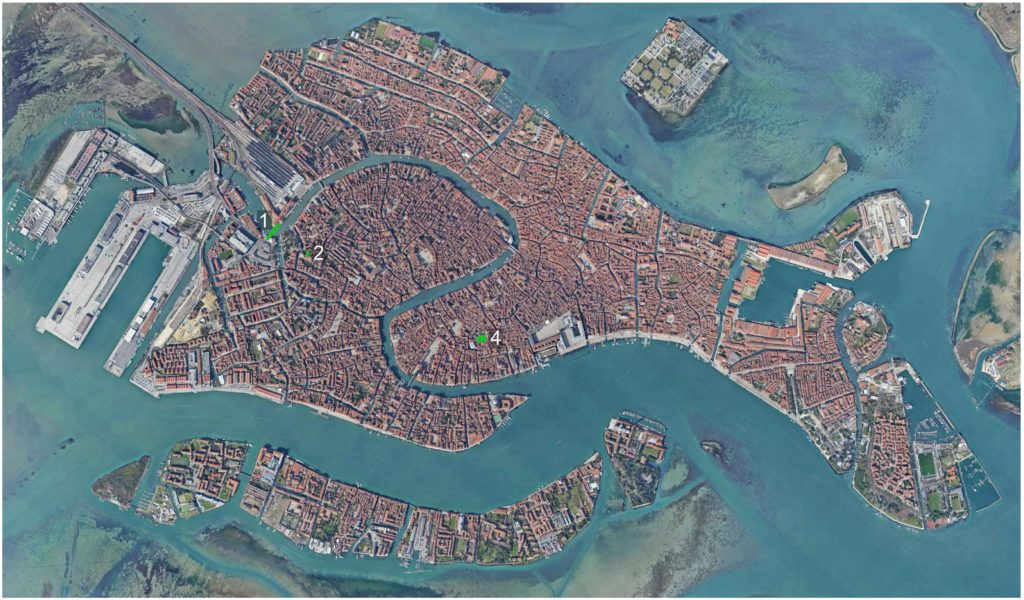
Map of Venice highlighting various works of Modern Architecture within the city.
Note: #3 on the list is not depicted
1. Constitution Bridge

Constitution Bridge, also known as the Ponte della Costituzione, is a modern bridge in Venice designed by the famed architect and engineer, Santiago Calatrava. Calatrava is famous for his use of modern contemporary forms, that can only be constructed with the use of cutting-edge technology and materials. You can clearly see this in the sleek sweeping curves of the Constitution Bridge. The steel structure of the bridge resembles the skeletal structure found within snakes and fish, and the distinct curvature greatly contrasts the rest of the surrounding buildings in the area.
2. Works of Carlo Scarpa

Carlo Scarpa is one of the most influential architects of the past century, and he was a distinctly Venetian Designer. Scarpa worked predominantly within Venice itself, and in the surrounding Veneto Region. The image above shows the main gate to the Tolentini building, which is the headquarters of the Università Iuav di Venezia. Here Scarpa uses several cast-in-place concrete forms to create a sculptural edifice that is distinctly modern. Carlo Scarpa also designed a bridge over a small canal that services the Fondazione Querini Stampalia. It’s located in the heart of Venice, not far from Piazza San Marco.
4. Venice Biannale
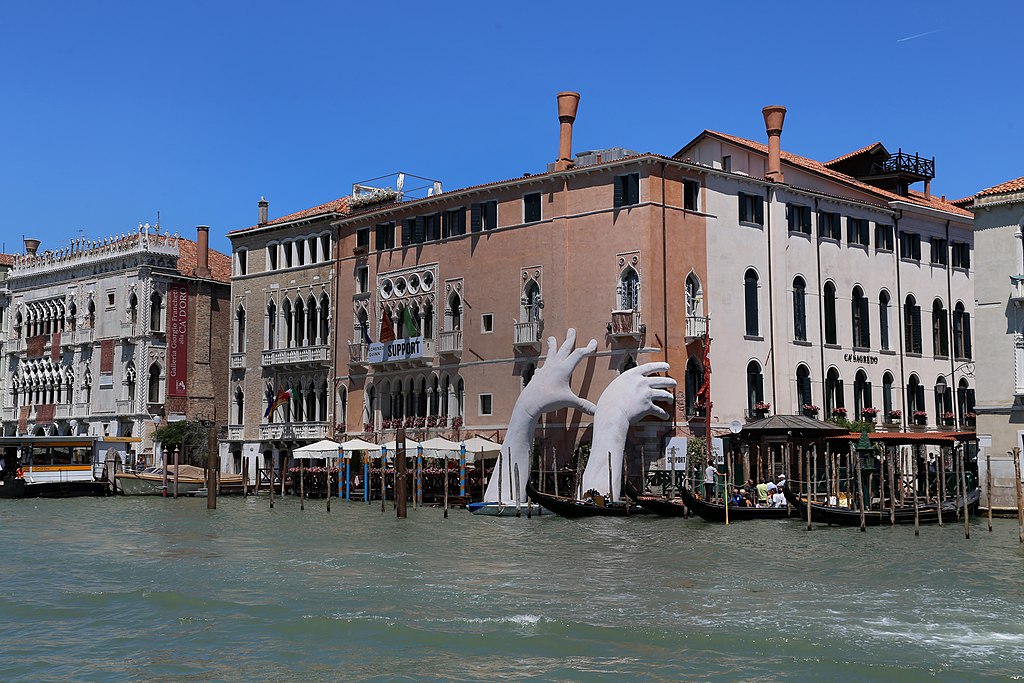
The Venice Biennale is an annual event held within the city that showcases a wide variety of modern art exhibits. Although not necessarily architecture, these art installations are world-renowned for their experiential designs and themes. The image above shows a work by Italian Artist Lorenzo Quinn which was part of the 2017 Venice Biennale. The two hands are reaching directly out of the waters of the Grand Canal and grabbing hold of a Venetian Gothic Palace. Quinn’s artwork was such a hit with visitors to the Biennale, that he was invited back in 2019 to do a follow-up art installation.
4. La Fenice
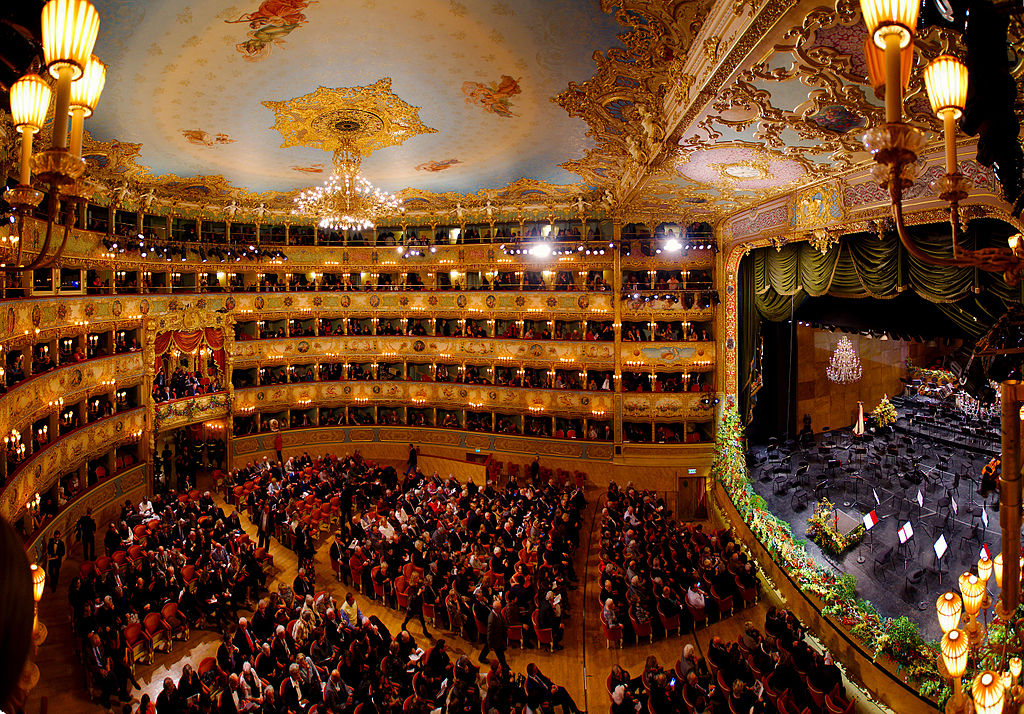
La Fenice is an Opera House located within Venice that was established in the late 1700s. It has been one of Venice’s leading performing arts venues since then, although the building itself has been destroyed on three separate occasions. It burned down and had to be rebuilt after fires in 1774, 1836, and 1996. After the third fire, the theater was closed for 8 years. The building was rebuilt and La Fenice eventually reopened in 2004. The current building is meant to replicate the historic versions that existed prior, but it was also built with all of the modern building systems that can be found in contemporary structures.
Neighborhoods of Venice
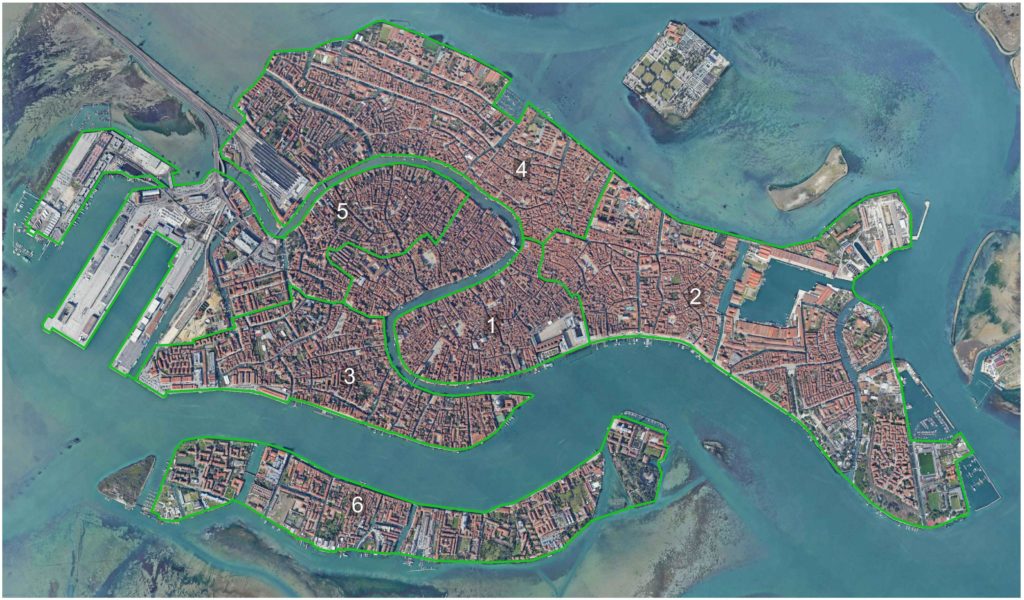
Map of Venice showing the extents of various neighborhoods within the city
.
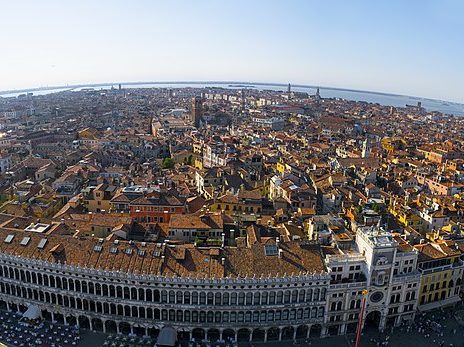
1. San Marco
San Marco is the most popular neighborhood in Venice for tourism. It’s home to some of Venice’s greatest works of architecture including Piazza San Marco, St. Mark’s Basilica, and the Doge’s Palace. San Marco is the liveliest neighborhood in the city, and its home to many of Venice’s most exclusive restaurants and hotels.
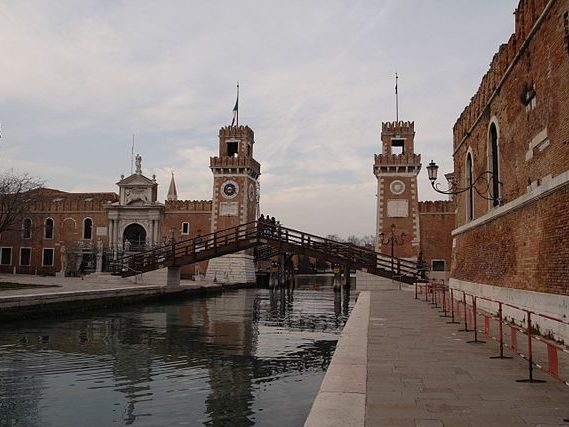
2. Castello
Castello is an area of Venice that is dominated by one main site, the Venetian Arsenal. The Arsenal was a large ship-making facility that was the source of Venice’s powerful navy. Nearby you will also find other important sites such as the Church of San Zaccaria and Chiesa di San Lorenzo.
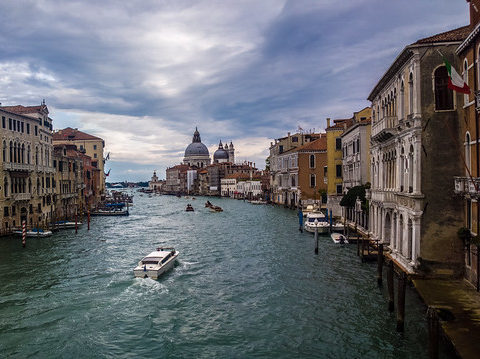
3. Dorsoduro
Dorsoduro is a neighborhood in the middle of Venice located across the Grand Canal from the San Marco neighborhood. It’s probably the city’s second-greatest neighborhood for architecture after San Marco. Within Dorsoduro, you will find the Basilica di Santa Maria della Salute as well as several of the Grand Canal’s major palaces.

4. Cannaregio
Cannaregio is located on the northern edge of Venice. It’s a quieter neighborhood that has a more residential feel than some of the others nearby. It’s a great area to get lost in, and if you stray far enough from the beaten path, you can sometimes find a canal all for yourself.

5. Santa Croce
Santa Croce is one of the more commercialized neighborhoods within Venice. It’s located right next to the main train station, and it’s also home to the city’s main shipping docks. The area can often get flooded with crowds because it’s where the cruise ships let off their passengers.
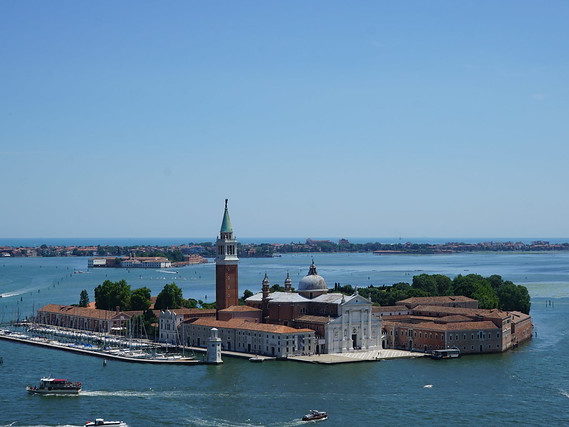
6. Giudecca
Many people visit Venice without crossing over to the island of Giudecca – and those people are missing out on some of Venice’s greatest works of architecture. Giudecca contains two incredible buildings designed by Andrea Palladio, Il Redentore and the San Giorgio Monastery.
Architecture of Venice: In Review
Venice is truly one of the most iconic and unique cities on earth. From its origins as a humble fishing village, Venice eventually grew into the grand capital city of the Republic of Venice – one of the wealthiest and most powerful maritime republics in Mediterranean history. Venice is the birthplace of Venetian Gothic Architecture and the Venetian Renaissance, and the city contains buildings from every major age in architecture. It’s one of the most popular tourist destinations on earth, and any fan of architecture is sure to be delighted by the splendor and brilliance of Venice.
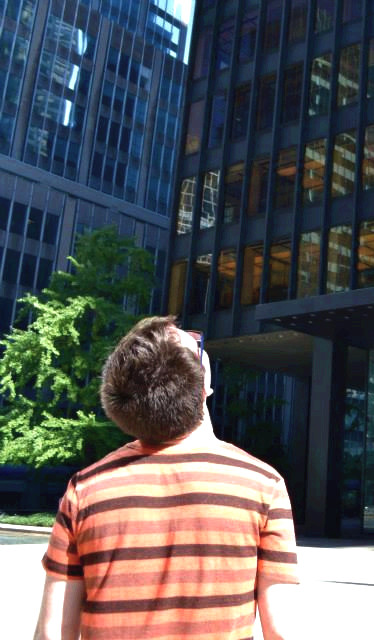
- About the Author
- Rob Carney, the founder and lead writer for Architecture of Cities has been studying the history of architecture for over 15 years.
- He is an avid traveler and photographer, and he is passionate about buildings and building history.
- Rob has a B.S. and a Master’s degree in Architecture and has worked as an architect and engineer in the Boston area for 10 years.
Like Architecture of Cities? Sign up for our mailing list to get updates on our latest articles and other information related to Architectural History.
